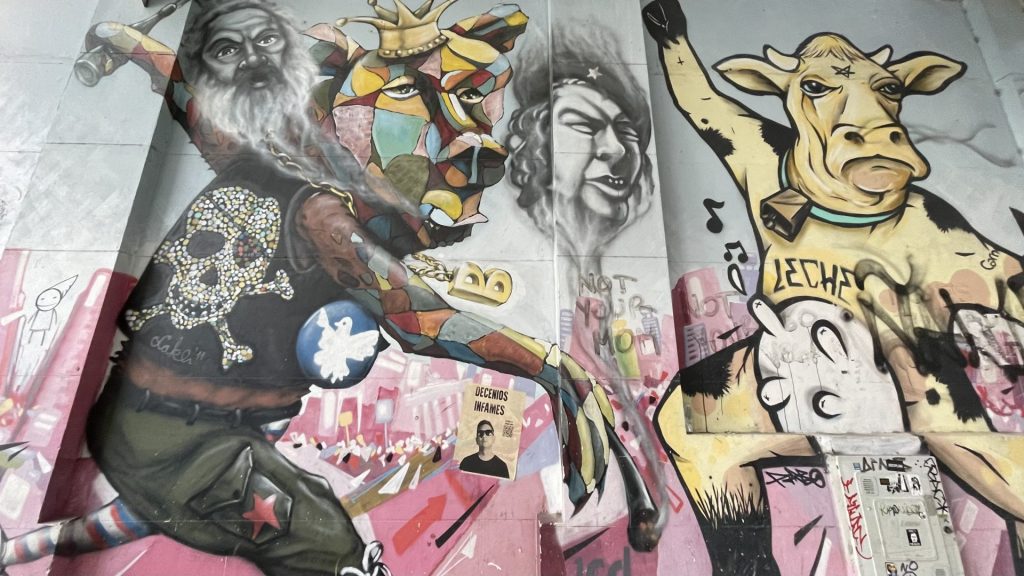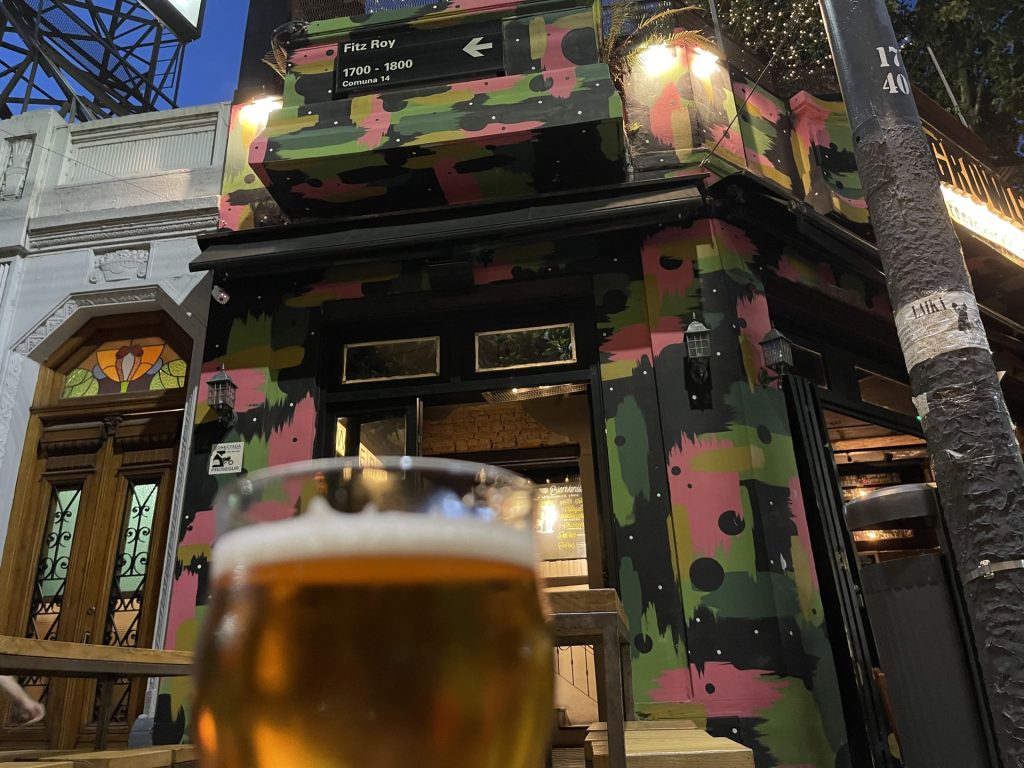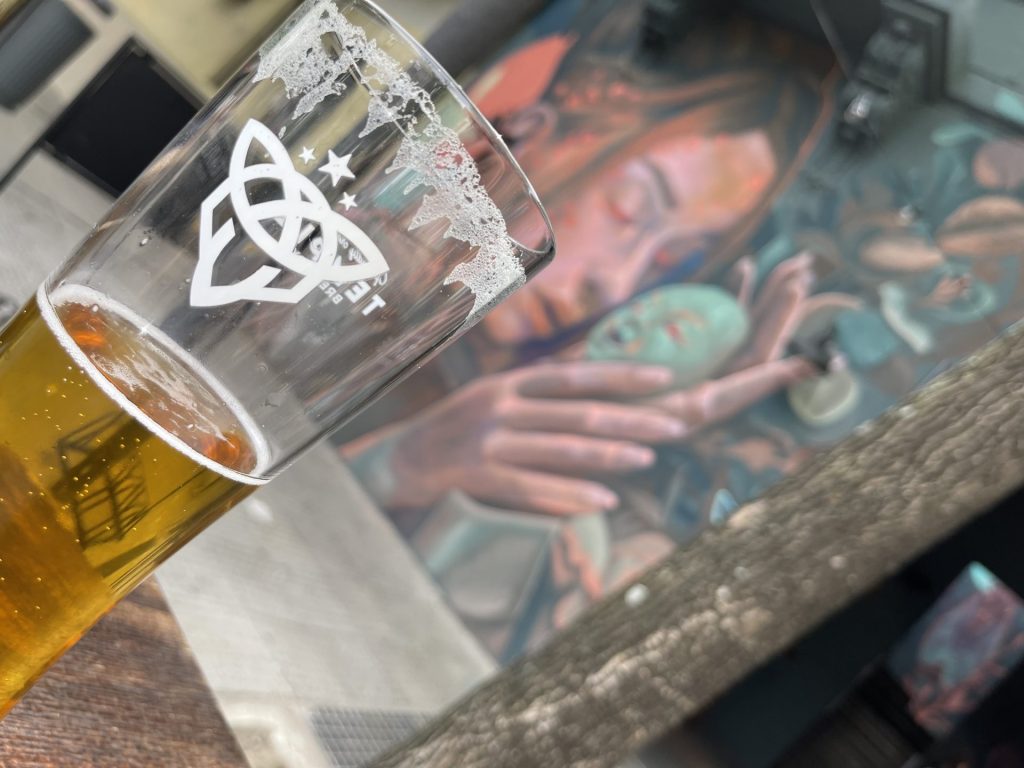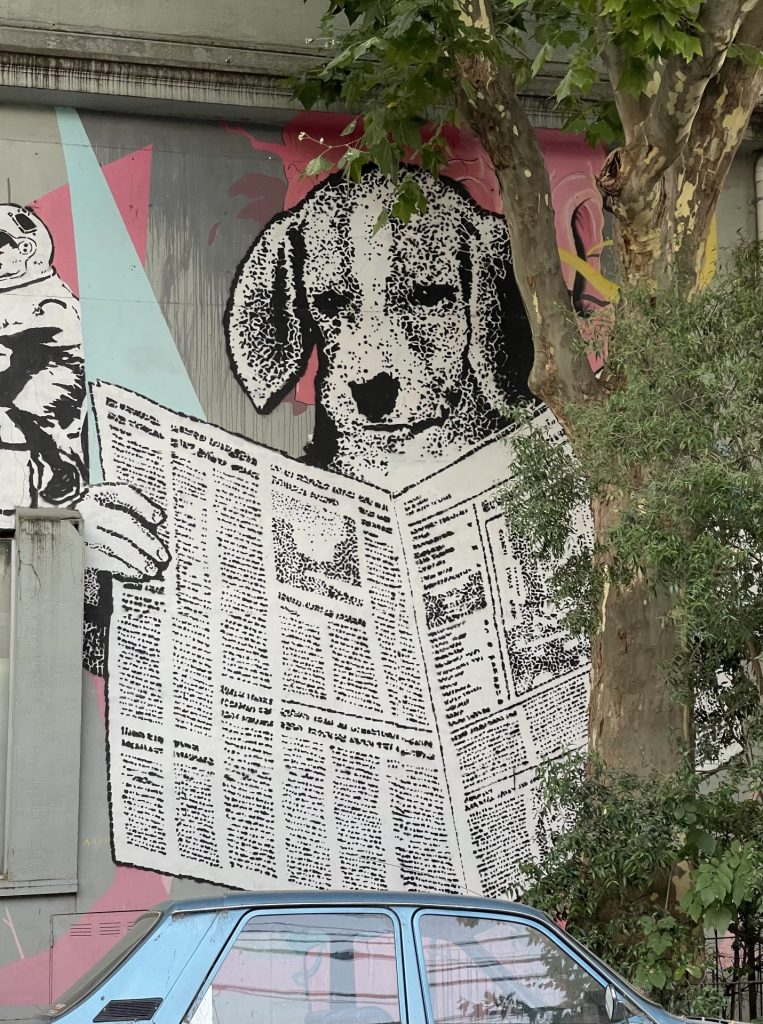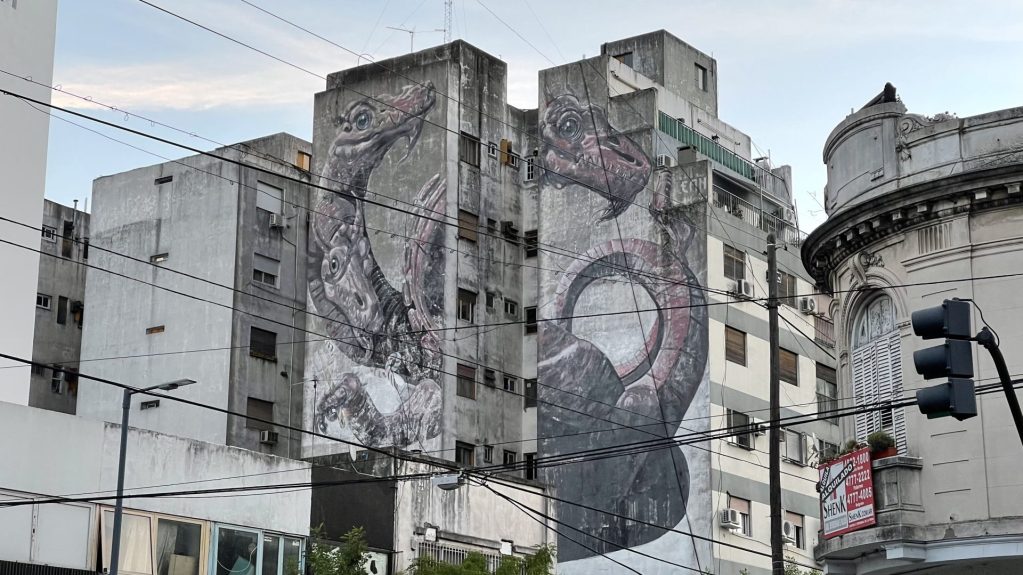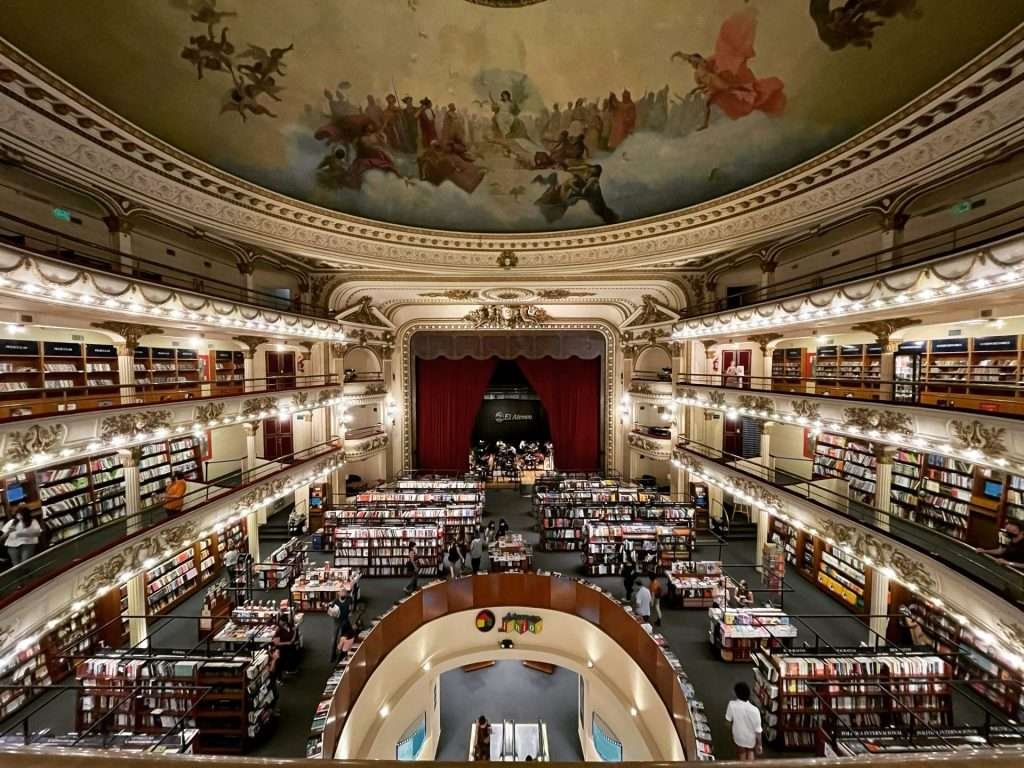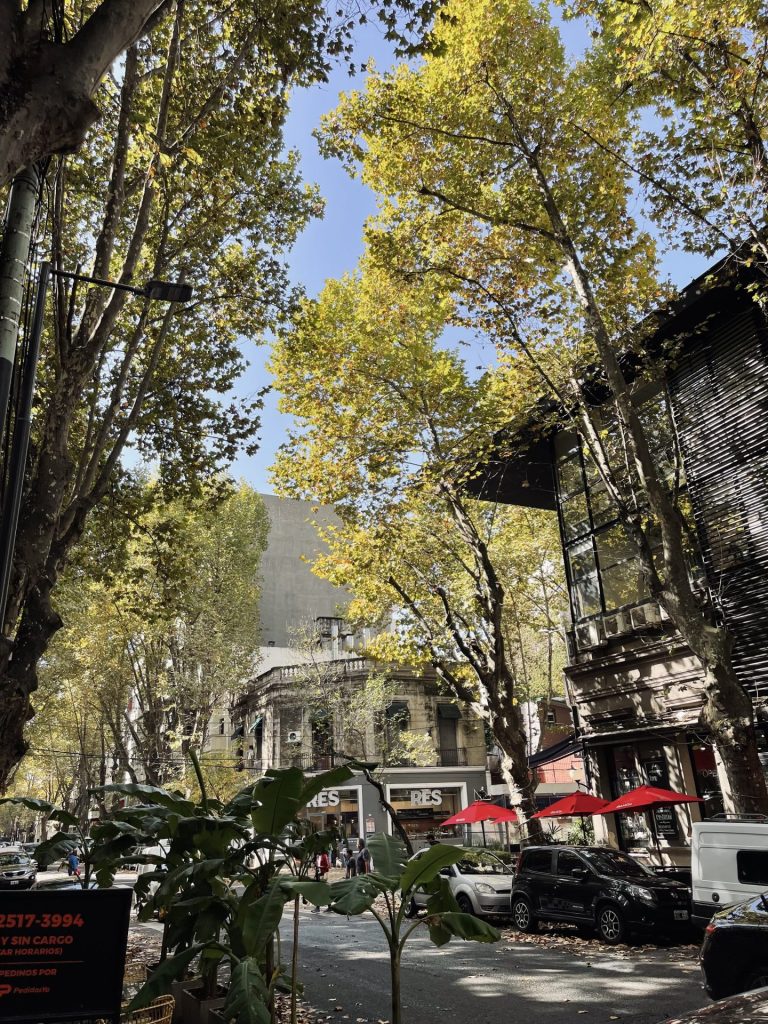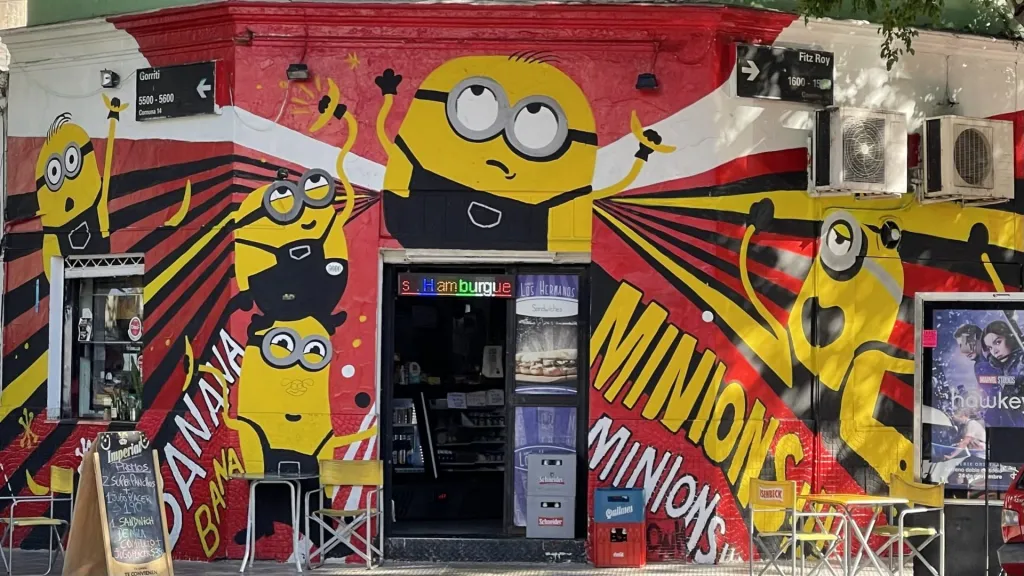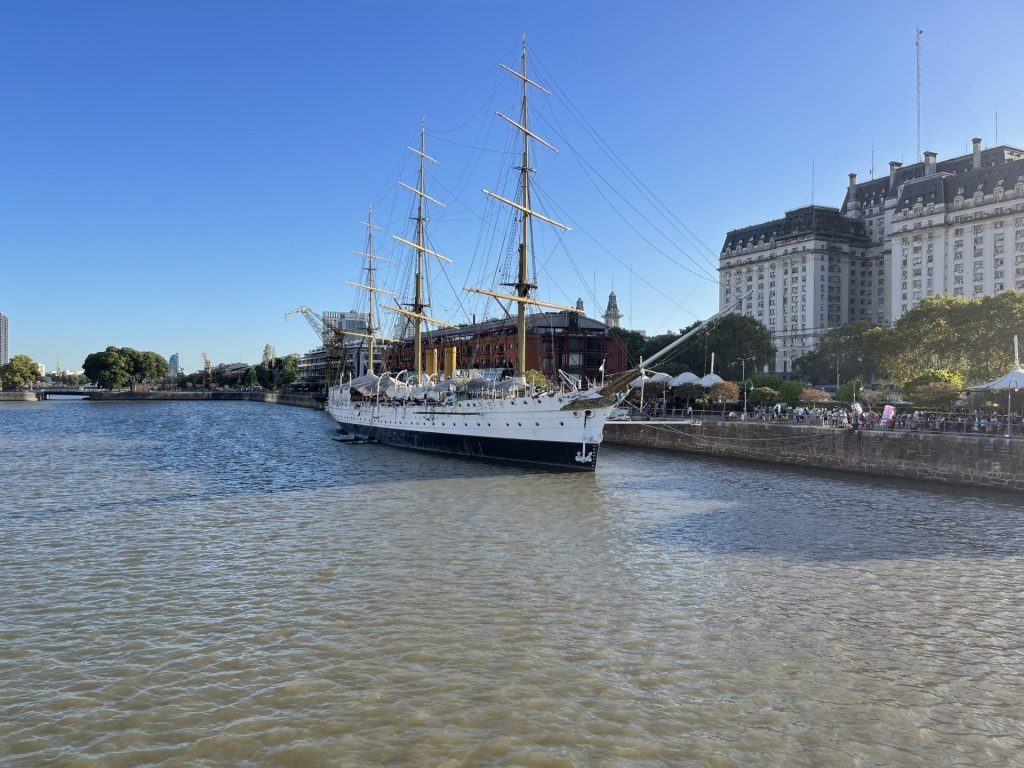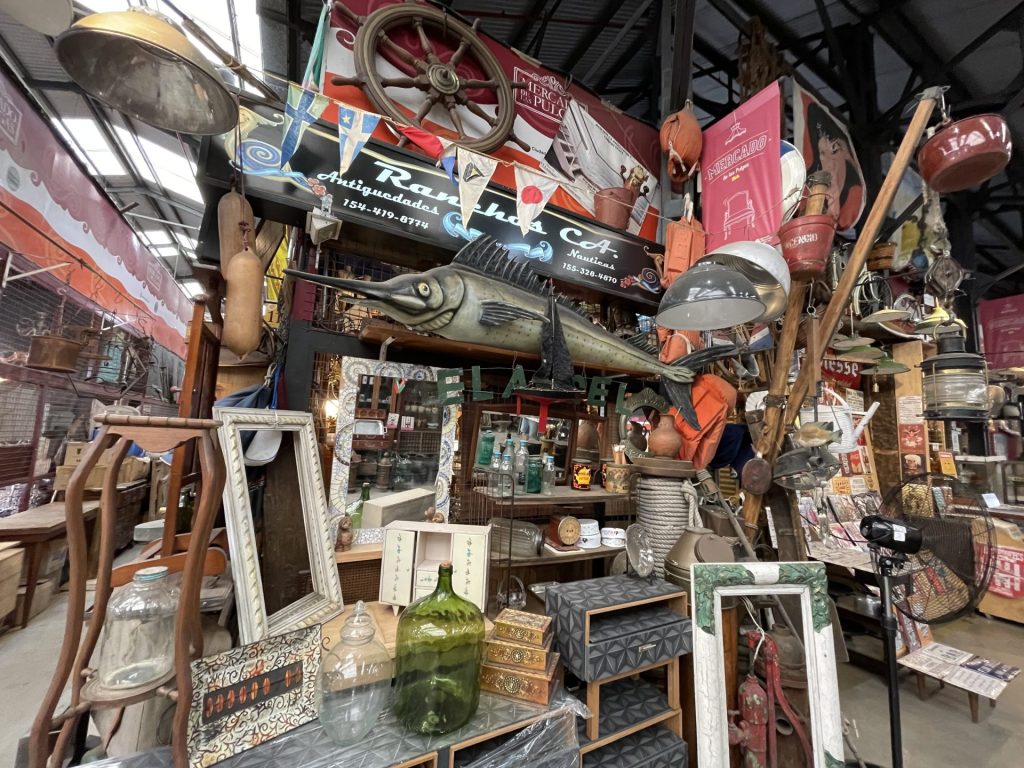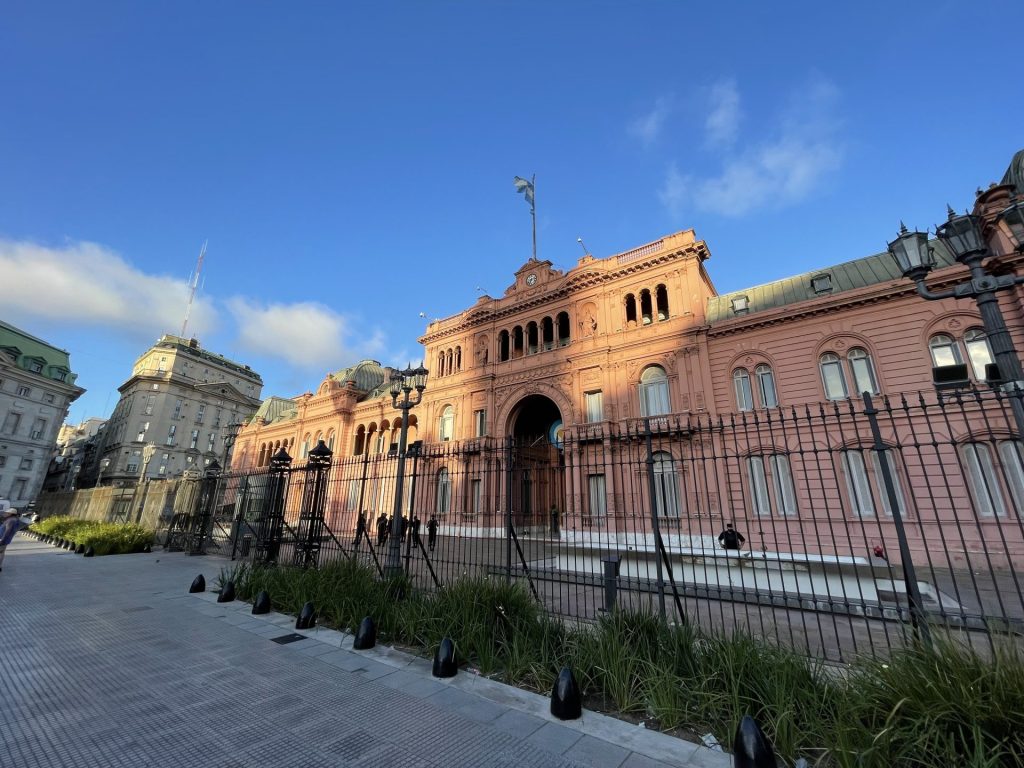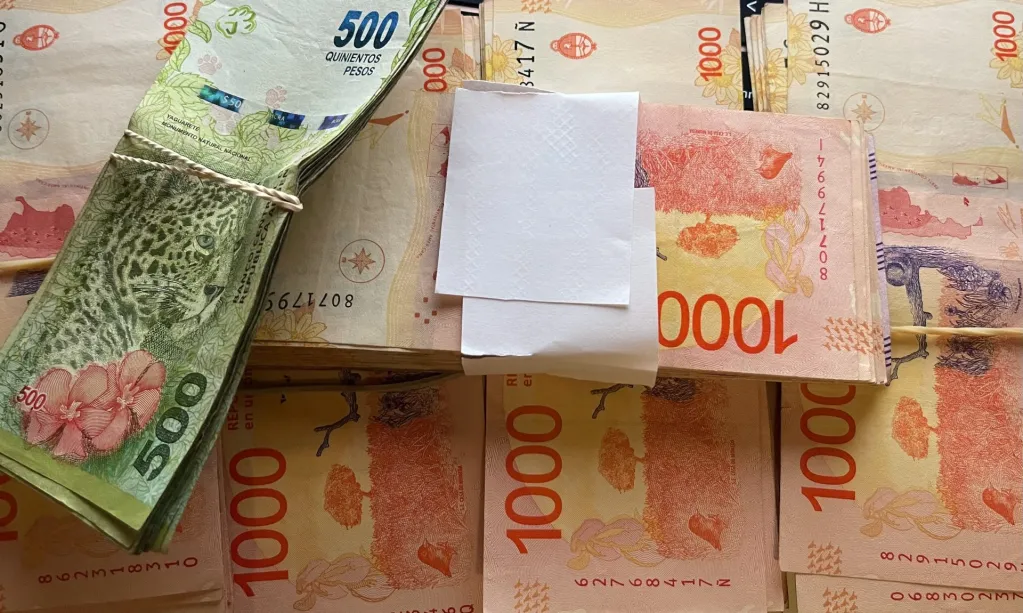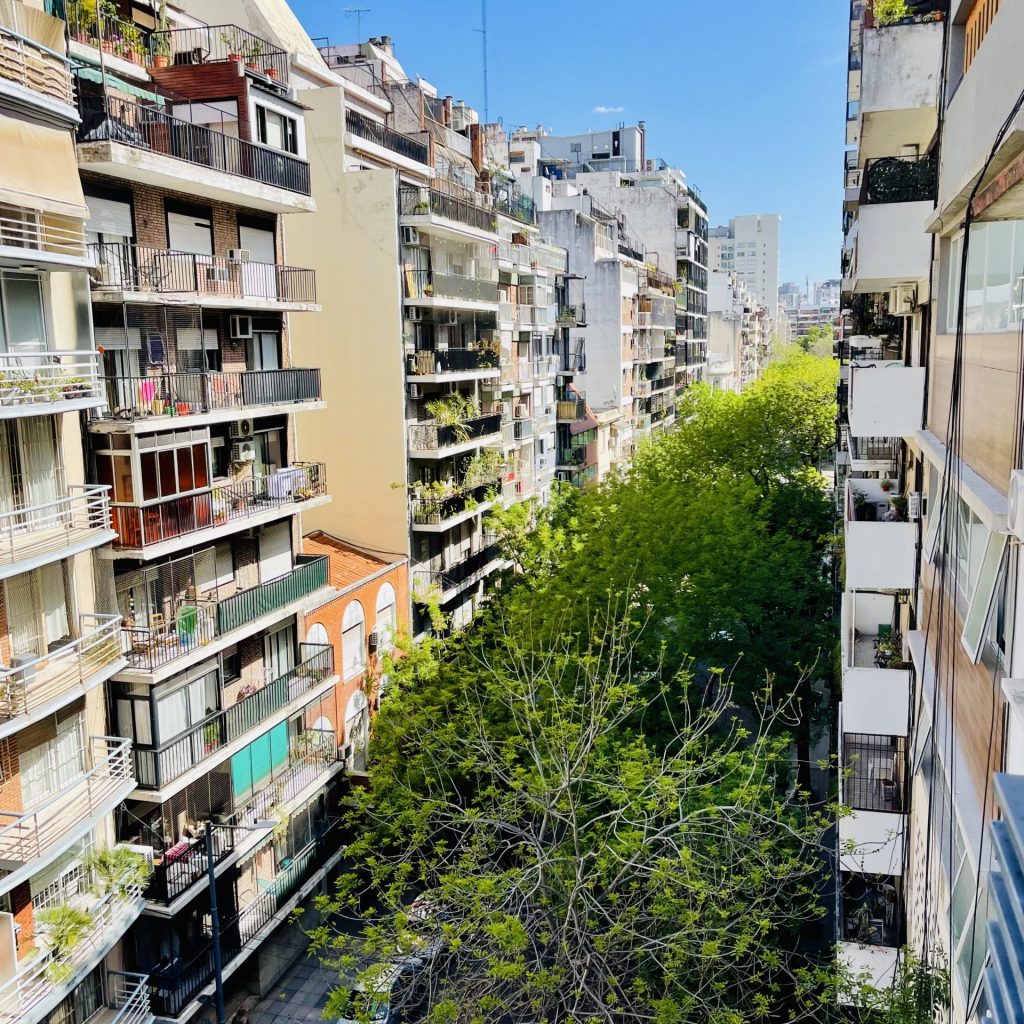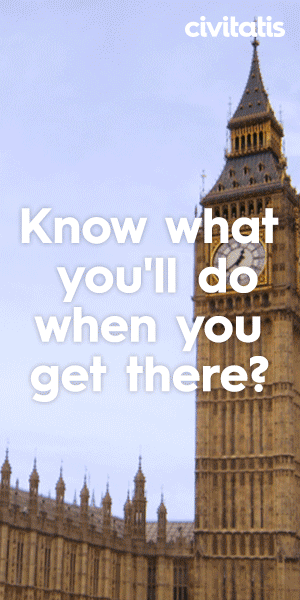If you’re planning a trip to Buenos Aires in Argentina, this article is for you. The first half of this article is dedicated to the things you should know about Buenos Aires before visiting. And the second half of this article covers the most popular tourist attractions.
Because I live in Buenos Aires for at least 6 months a year, and I’ve been here for the better part of the last 3 years, I’m always updating this article on a regular basis. The list of attractions will grow as I myself discover more hidden gems around the city. So, do bookmark this guide!
Travel advice for visiting Buenos Aires Argentina
What To Know Before Visiting Buenos Aires
Study this list carefully before you travel to Argentina. Most of these items apply not only to Buenos Aires, but equally well to the rest of Argentina.
I’d advise paying particular attention to the sections on Money and Scams. Knowing how to correctly access money in Argentina and what scams to avoid when paying for things will greatly improve the experience you have in Argentina.
And I would strongly advise all visitors to Argentina to ensure they do not travel without health insurance and without a VPN loaded onto their phone.
Safety – Is Buenos Aires Dangerous?
Argentina and Buenos Aires in particular are not dangerous. Buenos Aires as the capital and largest city in Argentina has more than its fair share of the crime that occurs in Argentina. But violent crime affecting tourists is extremely uncommon.
Where other LATAM countries are often plagued by crime affecting tourists, this is not the case with Argentina.
As an example, there were more than 50 tourists murdered in Medellin Colombia, just in the first half of 2022. Medellin is a city of 2.5 million people and stands in stark contrast to Buenos Aires, that has a much larger population of over 15.5 million and has had no tourists harmed.
I honestly can’t remember the last time I heard about a tourist being affected by armed robbery in Buenos Aires. The last tourist I remember hearing about being murdered was in 2019. Serious crime affecting tourists just doesn’t happen here in Argentina.
Buenos Aires has a very modern police force, that is equiped with all the latest tools (cameras, motorbikes, patrol cars). CABA (Ciudad Autónoma de Buenos Aires) has a heavy police presence. It’s not uncommon to see a police officer posted to every street intersection. And you’ll often be within sight of a police officer in the popular parts of the city.
The police in Argentina aren’t like police in some other LATAM countries. They will not seek bribes and act like a law unto themselves. The police in Buenos Aires are some of the most professional officers I’ve encountered anywhere in the world.
The biggest risks you face in Buenos Aires as a tourist are pickpockets (and other petty thefts) and stepping in dog poop. In order to avoid either of these eventualities, you just need to be aware of your surroundings and watch where you’re walking. And if you did have an item go missing, simply report it to the police.
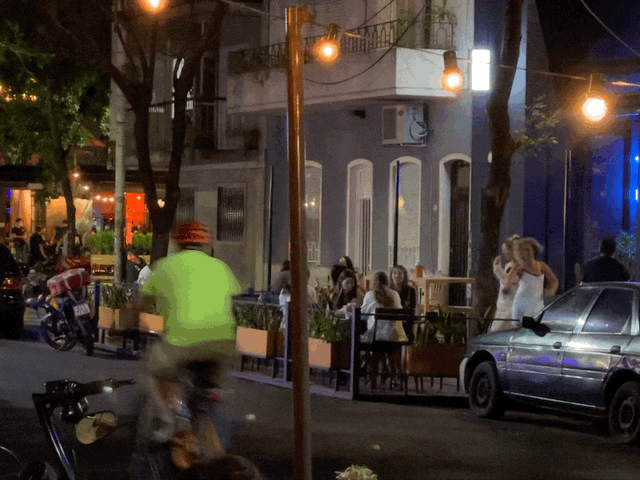
Packing – What Should I Not Take To Argentina?
As with any LATAM country you should avoid bringing expensive or ‘flashy’ jewelry. There are plenty of places around Buenos Aires where you can buy custom jewelry and fancy watches (i.e. Cartier and Rolex). But as a tourist it’s best not to wear those sorts of items when visiting places you’re not familiar with.
The only tourist I remember hearing about being robbed at gunpoint (and this was a few years ago now) was wearing all kinds of flashy jewelry including an expensive Rolex. It was a younger chap from the USA who thought he’d come down to Argentina and act all ‘baller’. Well, he went home healthy, but without his goods.
Don’t bring expensive jewelry with you. You need to remember that Argentina has a high inflation environment brought on by decades of economic mismanagement by successive governments. If you’re wearing a watch that’s worth as much as a local house, in poorer neighborhoods, it’s not only disrespectful, somebody might take it from you.
Scams – Know the Scams in Buenos Aires Before You Travel
I’ve previously covered the scams you’ll encounter in Buenos Aires. Yet it’s worth repeating the top 3 here, so as to ensure nobody falls for them.
The first is fixed price taxis. Registered taxis in Buenos Aires have meters in the upper passenger side portion of the windshield that tells you how much you’ve spent during your ride.
If a taxi driver gives you a fixed price from one destination to another, it’s a scam. Simply take a different taxi that will use the meter. Scam taxis are most common around the airport, bus terminal and buquebus (ferry).
The second are distraction scams for pickpockets, such as the mustard or bird poo scam. These are most common around very touristic, high traffic areas such as Casa Rosada and the blocks surrounding Avenida Florida in Centro.
Basically somebody, usually a couple behind you, will spray you with foul smelling goo and claim its bird poo. A Good Samaritan will then appear with napkins and help you clean it off while picking your pockets. Don’t fall for this one and don’t let strangers touch you – just quickly walk away.
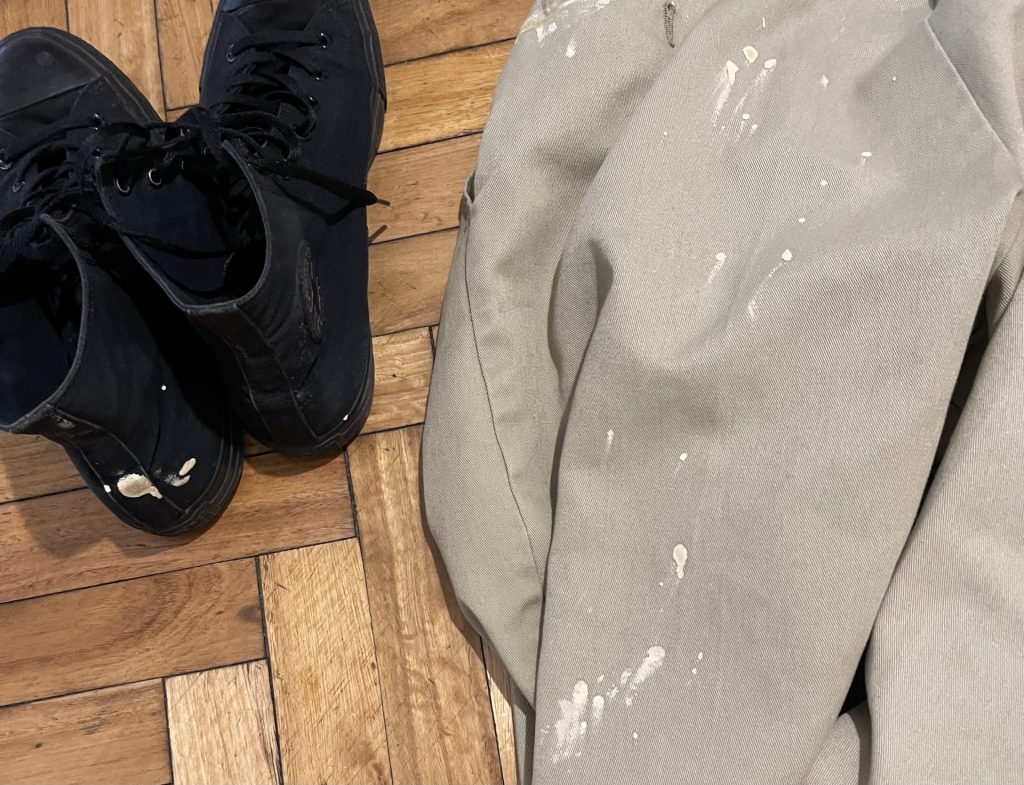
The third are ‘free drink’ scams. These are becoming much less common but you’ll still encounter people trying them on tourists in and around Centro and Avenida Florida. Basically, nothing is free in Buenos Aires.
So if a pretty lady or a handsome gentleman offers you a free drink you should say no and walk away. If you accept, your drink will be free but theirs will cost you hundreds of USD. And if you try to escape without paying the tab a couple of large gorilla sized bounces will lock you in and shake you down for cash.
Visa – Do You Need A Visa to Visit Buenos Aires?
The visa you need will most often be determined by how long you plan on staying in Buenos Aires. Tourists from most countries are eligible for a free 90 day tourist visa on arrival. This tourist visa is extendable for a further 90 days at the Dirección Nacional de Migraciones in Buenos Aires.
If you want to stay in Buenos Aires longer than 180 days, you can leave the country by traveling on the Buquebus to Uruguay and return to Argentina, with a brand new tourist visa. It’s called a ‘visa run‘. Argentina is starting to crack down on this. And they may give you a written warning, but they will still let you in to the country, as they need the tourism.
To see if you’re eligible for a free tourist visa, based on your passport, you can check the official list here. If you’re from Australia, New Zealand, USA, UK or another ‘first world country’ you’re definitely eligible.
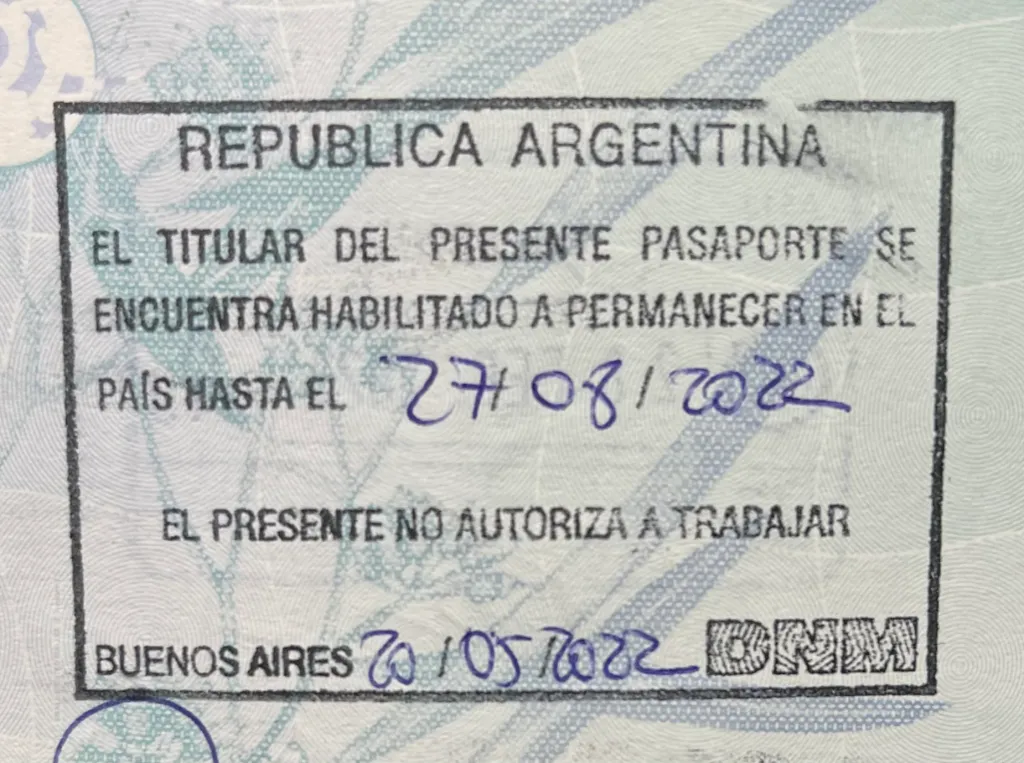
Best Website For Booking Flights To And From Buenos Aires
The best online booking engines for flights to and from Buenos Aires are WayAway and OMIO. I use these two sites for almost all of my own travel. And I recommend anyone looking for cheap flights to Buenos Aires, do check both sites.
One professional travel tip I would offer you, is to change the currencies at the top of the screen on both, when viewing flights. Sometimes, I find the flights work out cheaper when I’m billed in alternate currencies using Wise for payments.
You can view the available flights for Argentina at www.wayaway.com or on www.omio.com.
I’ll also add that you should absolutely avoid the Chinese owned trip.com. It has horrendous customer service and uses outsourced Indian call centers.
From my own experience of using it, I’ve come to believe that Trip.com is a scam website. And I actually lost a flight to Buenos Aires, because they had incorrect information on their website. Avoid trip.com and only use WayAway or OMIO.
Money – The Argentine Peso (AR$)
The offical currency in Argentina is the Argentine Peso (A$ or AR$). Unless you’re purchasing a property or vehicle, don’t expect to pay for goods and services in USD.
I’ve seen visitors from the USA try to pay at restaurants with USD cash and well, they were declined. And everybody in the restaurant had a less than desirable impression of them. They even garnered some ‘choice’ words from other patrons in the establishment.
When it comes to paying for goods and services always pay in peso. And do it with cash. Don’t use your credit cards or pay with Apple Pay or Google Pay in Argentina. This is because there is the official ‘red’ exchange rate and the unofficial ‘blue’ rate of exchange.
What Is The ‘Dólar Blue’?
The ‘Dólar Blue‘ is often referred to as the ‘blue dollar’ by foreigners. The dólar blue is the real USD to Argentine Peso exchange rate. It’s what the USD is really worth in Argentina.
The dólar blue is often double the official exchange rate. When you look at exchange rate sites like XE.com, or check the rate of exchange from your bank at home, you’re seeing the ‘official’ exchange rate.
Any transaction that goes through or interacts with an Argentine bank or payment processor will garner the ‘official’ exchange rate, set by the Government of Argentina. If you’re paying for goods and services using a card, then you’re paying more than double what everyone else is paying.
To view the real dólar blue rate of exchange, you simply Google ‘dólar blue’ or look at sites like https://dolarhoy.com.
Where Can I Get The ‘Dólar Blue’ In Buenos Aires?
There are two ways to get the ‘dólar blue’ rate in Buenos Aires. Though you’ll find its the same throughout the rest of Argentina, based on the availability of vendors.
The first method is by bringing USD cash to Argentina and exchanging it at any reputable currency exchange shop (casa de cambio or bureau de change). And you should only use reputable shops with actual signage.
Despite what you may have seen on YouTube from people who often spend only 3-5 days in Buenos Aires and then make videos (claiming expertise), the dólar blue is not a traditional black market. It’s not illegal and you don’t need to sneak around using shady money exchangers on the street in Avenida Florida (Florida Street) called Arbolitos (little trees).
If you’re going to change USD cash to Argentine Peso in Buenos Aires you will need crisp, new, unmarked $100 bills in pristine condition. You will only get the full dólar blue rate with the highest quality $100 USD notes of the latest series.
The easier method for getting Argentine Peso cash to spend in Buenos Aires is through Western Union. Western Union pays out Argentine Peso at or above, the current dólar blue rate. Using the Western Union mobile application to send myself money for collection in store, is how I bring my money into Argentina.
Because Western Union is easier and often provides a better rate than the dólar blue, it is the primary method I advise all visitors to use in Argentina. Unless you’re going out into the countryside or to Patagonia, you will always be within a few blocks of a Western Union outlet.
Theoretically you can transfer up to $50,000 at a time through Western Union. And there are Western Union dealers all over Argentina. In Buenos Aires there’s almost one WU dealer on every block. The problem is that most Western Union shops in Buenos Aires don’t have enough cash to deal with relatively small transactions.
Say that you send yourself $250. Then only about half the Western Union dealers in Buenos Aires will have enough cash on hand to process the transaction. If you send $500 then about a quarter of all stores will have enough cash.
If you send more than $500 then there really is only three Western Union outlet I’ve found that can reliably process larger transaction in Buenos Aires. The Western Union outlets in Buenos Aires that are guaranteed to have enough cash, are:
Note: All 3 of the above Wester Union outlets are on the same block in Recoleta. If one of them has a line, check the others to save time. They all get their cash from the ICBC and they never run out.
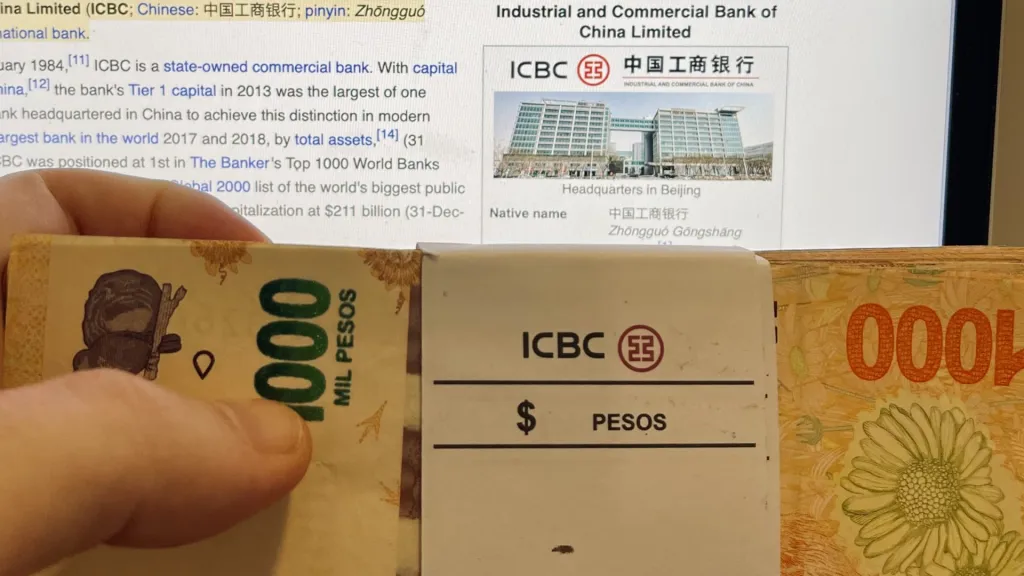
Is There A Dólar Blue In Uruguay?
In Argentina with its soaring inflation and beaten down peso, nobody keeps their cash in the local currency. When combined with currency controls the constant need for dollars to avoid inflation drives a thriving unofficial currency conversion rate known locally as the Dólar Blue.
Given its proximity to Argentina, with their financial woes, most first time travelers to Uruguay will assume that Uruguay’s currency situation is going to be similar to Argentina. Yet it’s not. You should avoid money changers in Uruguay.
Should I Tip In Buenos Aires Argentina?
Tipping is customary in Buenos Aires. Tip at restaurants, spas and barber shops when getting your haircut. Porteños don’t tip taxi drivers, shop clerks or hotel staff.
Tip 10% on average to waitstaff in restaurants if they haven’t already included a service charge on the bill. Don’t tip if they have included a service charge as they are already tipping themselves.
Seasons – Best Time To Visit Buenos Aires
Spring, summer and autumn (fall) are the best times to visit Argentina. The capital, Buenos Aires, is in the southern part of the country and has temperatures that can range from near freezing to sweltering hot.
In summer, you will often experience temperatures in the high 30’s (celsius). And the Sumer temperatures can (and do) get up into the mid 40’s (celsius).
Most websites will tell you that Buenos Aires is a Mediterranean climate. I’ll tell you that winter is bone chillingly cold and that summer can melt the rubber soles of your shoes. So pack based on the season you’re visiting.
Nights in summer are jeans and a light shirt. Winter is jeans and a warm jacket at minimum during the day. For the single men reading this, summer is the time you want to visit. Because the summer dress code for ladies is short shorts and skimpy tops.
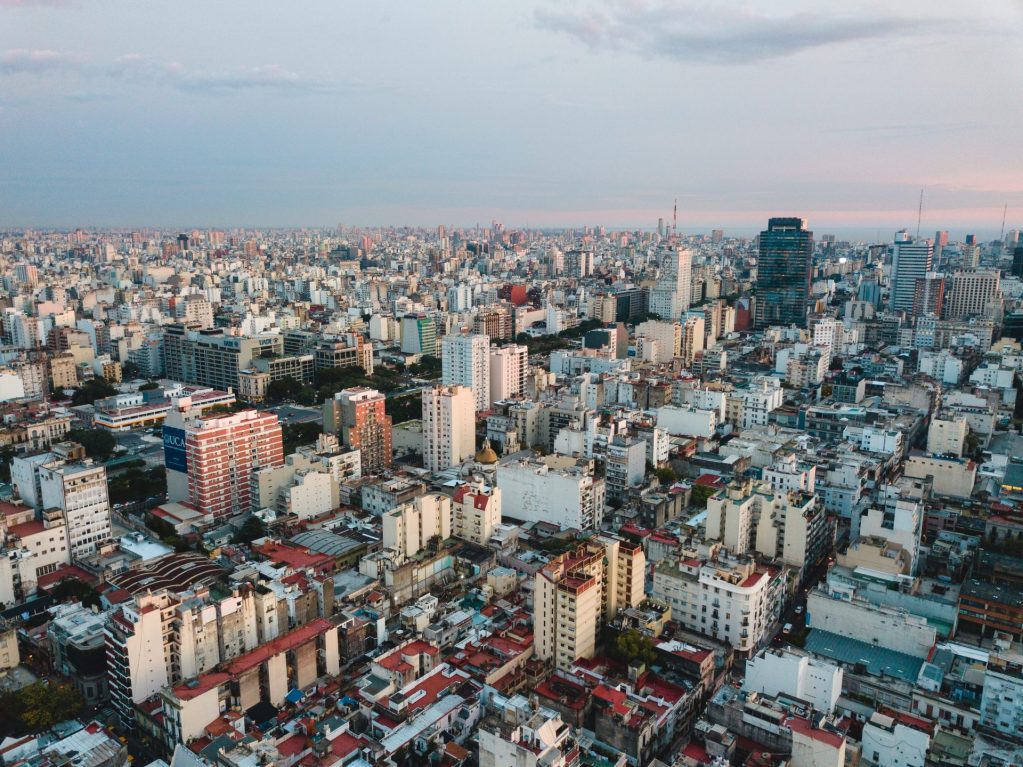
Restrictions – Are There Any Travel Restrictions In Buenos Aires?
There aren’t any travel restrictions currently in force in Argentina, for those people who have had the full course of COVID19 vaccinations. For those who are unvaccinated, there are PCR testing requirements.
Smoke And Vape In Buenos Aires
Smoking and vaping are legal in Argentina. And both smoking and vaping are only permitted outdoors. For those who vape, you can bring your own vape to Argentina. And you can buy vape products in Buenos Aires.
To buy vapes in the city, you can order online or buy them in stores. I get my own vapes from 3 main source. And they are:
- Vape Queen Tienda (vapequeentienda.com)
- Galería Bond Street in Recoleta
- Freedom Grow Shop in Palermo Hollywood
Note: Most of the information on the internet is wrong. I’ve vaped all over Argentina in Buenos Aires, Mar del Plata, Bariloche and Salta. I’ve flown in and out of Argentina with vapes in my baggage. I’ve also taken the Buquebus to and from Uruguay with my vape device and I have never had a problem. And do note, Galeria Bond Street is definitely worth visiting, it’s near El Ateneo Grand Splendid.

Marijuana – Weed Laws In Buenos Aires Argentina
Marijuana is legal in Buenos Aires for personal use. You can buy and smoke weed in Argentina. Just don’t make a nuisance of yourself with marijuana as there are ‘nuisance’ laws.
Don’t smoke weed in places where smoking is not permitted. And don’t smoke weed where you might annoy someone else. If you cause problems for other people, that’s when you’ll have a problem.
Travel Insurance For A Holiday In Buenos Aires Argentina
Argentina has free health care for residents and visitors alike. Though the free health facilities available are not of the highest quality. They’re strained to their limits and are suffering from a lack of funding.
Leave the ‘free’ healthcare for the locals. And travel with proper travelers medical coverage. Argentina has an extensive private hospital system that is world class. With adequate travel medical coverage you can access this first rate, first world, medical system.
You can find more about traveler medical insurance coverage and what I use in Argentina here.
Where To Stay in Buenos Aires
Every neighborhood in Buenos Aires has a distinct history and vibe. BA is a mega city of over 15.5 million people. For example, Palermo Hollywood is named for its numerous radio and television stations. And Palermo Soho is filled with artists and boutique fashion stores.
Belgrano is home to wealthier older couples and families. While Floresta is more mulata and working class with a strong asian (Korean and Chinese) community.
Centro is the busiest ‘centre’ of the city. And Centro in Buenos Aires smells like an open sewer at night and of exhaust fumes during the day. Centro is my least favorite part of Buenos Aires.
The Best Neighbourhoods In Buenos Aires
The best area to stay in Buenos Aires, in my opinion, is Palermo. The sub-districts of Palermo Hollywood and Palermo Soho, have the highest density of restaurants and cafes anywhere in the city.
Yet, the high-rise living in Palermo Hollywood, compared to the lower rise living in Soho, minimizes exposure to traffic noise. And you can walk from one end of Palermo Hollywood to the other side of Palermo Soho in under 45 minutes.
If you’re wanting to be closer to the more touristic end of town, while still maintaining easy access to all the restaurants and nightlife, consider Alto Palermo. I find Alto Palermo quieter and the stock of available budget friendly accommodations better.
In Alto Palermo, I’d suggest looking at the Babel Alto. And in Palermo Hollywood, I’d suggest the Studio FR Palermo Hollywood. I’ve spent more than 6 months living in each and in my opinion, both are excellent value. Though the Babel Alto is the better of the two because the rooms are bright, airy and quiet.
For a full run down of my preferred hotels and other neighborhoods, see my guide to the different neighborhoods and hotels in Buenos Aires.
For Longer Stays – Paying For An AirBnB In Cash
No matter where you choose to stay in Buenos Aires, Airbnb and Booking.com will be your go to apps. For short stays its quite convenient to simply book and pay for accommodation through these websites. With booking.com often being the cheaper of the two with the largest selection of accommodation options.
For longer stays of a few months or more, it’s best to seek out cash rentals. You can find cash rentals through real estate agencies, mercadolibre or by asking your current provider if they would do you a deal off the platform for cash.
Most airbnb hosts will do you a cash deal that is up to 50% cheaper than what is listed through airbnb. And I’ve provided a breakdown of one such airbnb cash deal and how I found it here.

Arriving In Buenos Aires
Arriving into Buenos Aires for the first time, you’ll likely arrive by air at the Ezeiza (EZE) airport. Or via the Buquebus (ferry) from neighboring Uruguay.
In either eventuality your first two problems will be where to get Argentine pesos to pay for transport. And which transport option to take in order to arrive at your accommodation.
Don’t Change Money At The Airport
First, don’t change money at the airport, buquebus or pay for transport in foreign currency, no matter how insistent the taxi drivers are that they want a fixed fee in USD.
The main taxi scams encountered in Buenos Aires are at the airport and at the buquebus. The taxis will try to charge you a fixed sum in USD. Don’t do this. Taxis in BA are metered and if they’re quoting a fixed fee, it’s a scam.
And don’t run for the exchange office in these locations. As you will only get the offical government rate which is half the real exchange rate.
Getting From The Airport To The City In Buenos Aires
So, without local currency and without changing money into local currency at the Ezeiza (EZE) airport or buquebus terminal, how do you get to your accommodation?
If you have Spanish language skills you can often negotiate with the taxi drivers who aren’t trying to scam you or select one of the other transport methods available including Uber and private airport transfers which are cheaper and more convenient than Uber.
Uber From The Airport In Buenos Aires
Uber is available in Argentina. But it’s most common in Buenos Aires. It’s less common in the rest of Argentina and simply unavailable in towns like Bariloche or Ushuaia.
Personally, I only use Uber when taxis are trying to scam me near the buquebus terminal or from Ezeiza (EZE) airport if I’ve forgotten to book a transfer. This is because Uber in Buenos Aires is more expensive than the taxis and inconvenient because you need to wait for the Ubers only to have them repeatedly cancel.
The vehicles on Uber in Argentina are often nowhere near as convenient, comfortable or as modern as the taxis. But If you do take a Uber in Argentina, always be aware of surge pricing and only pay cash in pesos. From the airport and using your card through Uber, check the peso price displayed by Uber in your home currency before accepting the Uber price and ordering the Uber.
Be aware that the Uber won’t stop near the taxi rank or in-front of the Ezeiza (EZE) airport. You’ll be dragging your bags all over the carpark looking for your Uber. Pre-booked airport transfers are cheaper, more convenient and more comfortable.
Taxi From The Airport In Buenos Aires (Beware Of Scams)
You will most likely only ever experience taxi scams near international points of entry into the country. Everywhere else the taxis are modern, reliable, safe and clean. Skip Uber and opt for the taxis except around the airport or buquebus.
If the taxis try to tell you that the price to your destination from the airport or buquebus terminal is a fixed price in USD or pesos, do not get into those taxis.
They are dishonest and are trying to scam you. Don’t trust them if they relent and agree to use the meter. Avoid those taxi drivers and take another transport option.
Taxis in Buenos Aires have meters on the upper windshield on the passenger side. And they should always use the meter to determine prices.
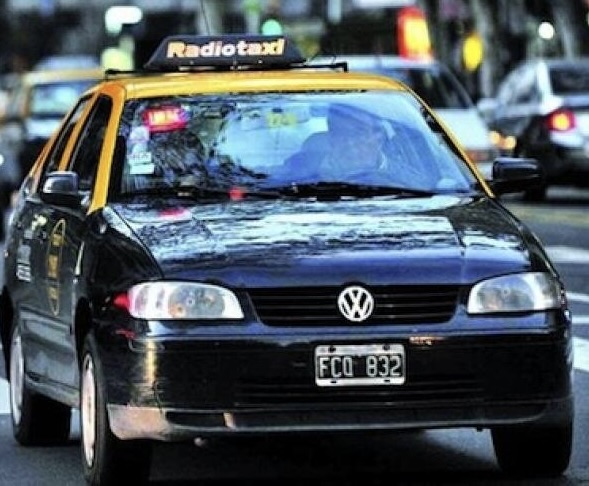
Using A Mobile Phone In Buenos Aires
If you’re only in Argentina for a short stay (few days or a week) your foreign mobile phone will roam in Argentina. If your carrier is going to charge you excessive roaming fees, international SIM cards can be purchased ahead of your trip online.
Where To Get A Local SIM Card In Buenos Aires
For anyone staying for a month or more, a local SIM card is easy to get in Argentina and is extremely cheap. You will need to buy the SIM card from a kiosk, activate it in the carriers store with your passport and then put credit on the activated SIM card at another kiosk after activation.
I’ve detailed the process for getting a local Argentina SIM card in Buenos Aires. You can find my article on how to get a local mobile phone number in Argentina here.
Always Use A VPN in Buenos Aires
If you want your phone to work in Argentina as it does in your home country and do not want to be hacked, you need to use a VPN while traveling.
I use and recommend NordVPN for Argentina and would recommend getting it ahead of time and using it to see the local prices. This is why I recommend NordVPN for Argentina and how I recommend using it.
Tinder In Argentina
The mobile application Tinder does work in Argentina. And it’s highly prevalent in Buenos Aires. Though if you’re looking to date an Argentine your best option is to go and have drink in one of the many local bars.
Argentines and portenós in particular are very social people. They prefer to be out and about as opposed to swiping on mobile applications.
But, you will need WhatsApp to get phone numbers and chat with them. And WhatsApp is one of the most important mobile applications for Argentina.
Here’s what you need to know about Tinder in Argentina.
Most Important Mobile Applications In Buenos Aires
There are five important mobile applications to have loaded onto your device before traveling to Buenos Aires Argentina. And they are:
- NordVPN
- Western Union
- Rappi or PedidosYa (or both)
- Wise (digital debit card)
Note: I use Wise in Argentina and have it linked to my Western Union account for cash. I use Wise because it helps cut down my currency conversion fees through mobile apps. And when I send money to myself via Western Union, I can verify the transaction through the Wise mobile app. Meaning I don’t have to deal with the ‘verified by visa’ SMS messages and I don’t need to continually change the SIM cards in my phone.
Drinking The Tap Water In Buenos Aires
Technically you can drink the tap water in Buenos Aires. For me, personally, I don’t drink the tap water in Buenos Aires. I’ve previously written about why I don’t drink it and what’s in the tap water. But the long and short of it is, it tastes like swimming pool water. And it’s full of nastiness I don’t want to consume.

Where To Buy Groceries in Buenos Aires
The main supermarket chains in Buenos Aires are Carrefour, Jumbo, Coto and Día. With Día being the most prolific depending on where you’re staying within the city. In the Palermo, Recoleta and Centro neighbourhoods you’ll almost always be with a 5-10minute walk from a Día.
There are hole-in-the-wall mom and pop kiosks on every block. But these are often much more expensive than the larger chain supermarkets. As an example near me, there is a kiosk right next door to the Día. And it buys its products from the Día, only to resell them for more than double the supermarket price.
Within CABA (Ciudad Autónoma de Buenos Aires) the larger chain supermarkets are all open every day of the week until 10pm. After 10pm you will need to pay higher prices via the kiosks.
Note: If you’re looking for more exotic items, then the asian supermarkets are fantastic. Particularly, if like me, you like spicy sauces. Because you won’t find a large variety of imported goods or spicy foods in the large chain supermarkets.
Food Delivery Apps In Buenos Aires
Argentina no longer has Uber Eats. And Uber Eats no longer functions. PedidosYa and Rappi are the two dominant delivery apps in Argentina. To use either app you will need an active phone number (either a local Argentina number or a roaming foreign SIM) and WhatsApp.
With either PedidosYa and Rappi, you can have any type of food delivered. With thousands of restaurants to choose from. And PedidosYa often works out cheaper than Rappi.
You can also shop for a myriad of other products on PedidosYa, Rappi and MercadoLibre. They carry everything from supermarket items to kiosks, pharmacy, travel, fashion and home furnishings to name just a few. You can buy and have delivered just about any item you can think of.
Just be sure to have WhatsApp enabled on your phone if you’re ordering through these apps. As this is how the delivery driver or courier will likely seek to contact you.
Travel tip: The range of restaurants that you see as available, will change based on your actual location within Buenos Aires. For instance, if you’re in Palermo, you will have a different range of restaurants available to you on PedidosYa and Rappi, then if you were in Microcentro.
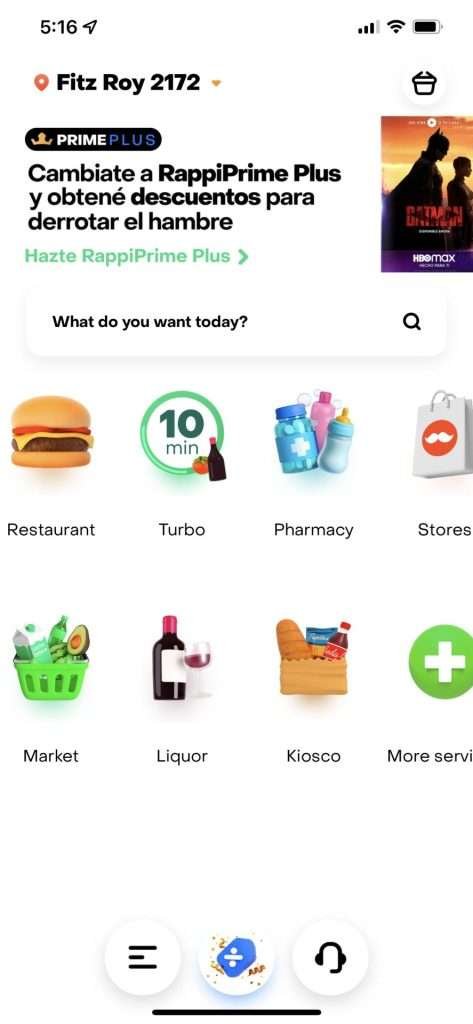
Delivery Apps In Argentina – Look Out For Automated Tips
The final thing to be aware of with food delivery apps in Argentina are automated tips. Rappi in particular is horrible for this. Instead of paying it’s delivery staff (independent contractors) a liveable wage, it will add on a tip in the back end of the app.
The tip amount that Rappi adds on to orders can be found and altered by customers. But it takes some digging around to find it. When you do, you’ll also see all the other charges they add to your bill. And it looks like this:
| Fee | Rappi (September 2022) |
| Service Fee | A$149 |
| Delivery Fee | A$109 |
| Tip | A$200 |
The tip amount added to your bill by delivery apps will change regularly. And it’s not the only tip you will pay the food delivery courier. As they will also expect a cash tip. Or they’ll simply have no change to give you. And the automated tip amount will go up randomly and without warning, so keep an eye on it.
The automated tip you give the delivery person via your chosen food delivery app is not tied to the quality of their service. If the courier with your sushi rolls decided to go home for a siesta with your food in their backpack, only to try and deliver it hours later, you can’t remove the automated tip from the bill. You laugh, but I’ve had it happen.
Personally, I entirely zero out the automated tip. And I only tip in cash direct to the courier. If the courier takes hours to deliver something and it’s a cold mess, they get no tip. If it comes in a moderately decent condition and isn’t hours late, I give them a big tip. And I’ve had decent success getting my orders on time by linking the tip to the condition of the delivery.
Getting Around Buenos Aires
Buenos Aires has an extensive public transport system composed of trains, subway system and bus routes. Though for a foreigner with cash acquired at the dólar blue rate a taxi is the easiest transport method. And a taxi only costs a couple of dollars for a long ride across town.
Uber is available in Buenos Aires but is less convenient and often more expensive than a regular taxi. I won’t consider using Uber in Buenos Aires unless I find myself around the Buquebus terminal or Ezeiza Airport where taxi scams are common.
If and when I do use Uber I always select the option to pay cash and ensure I’m not getting surge pricing. Surge pricing can quickly 10x the price of an Uber in Buenos Aires.
Paying by card through the Uber platform attracts the official exchange rate thereby doubling the price. If you were to get hit with surge pricing and the official exchange rate, you could end up paying 20x the price of a taxi fare.
Shopping In Buenos Aires
If you’ve never played old school video games it’ll be hard to picture what shopping in Buenos Aires is like. And I mean those really old video games back when they had ‘quests’.
Because you’ll never find everything you’re looking for in a single place. And simple tasks that we foreigners don’t even think about back in our home countries, will involve running all over the city in Argentina.
Shopping In BA Example – The GoPro Quest
For example, I recently bought a GoPro as I’m starting a YouTube channel. Buying a GoPro and its accessories would be easy, you’d think. In the USA, Canada, the United Kingdom or Australia you’d simply go to a store that sells GoPro and buy everything with your card. Not in Argentina!
To get items in Argentina you’ll need to first locate each item and its accessories on your list. They will each be in a different store and those stores will be all over the city. You’ll then need to go to each store and get a price for each item.
Once you have a price you’ll need to transfer the funds in through Western Union or another means to get the dólar blue rate. Otherwise your purchases will be inordinately expensive.
If you can’t get enough cash from a single Western Union outlet you’ll need to run all over town to find a WU that has enough cash. Before going back to each store and buying each item on your list.
Only once you have each item safely home in your accommodation is your quest over. Just pray that the vendors you’re buying items from have a cash counting machine. Or you could be there for hours trying to count the cash.
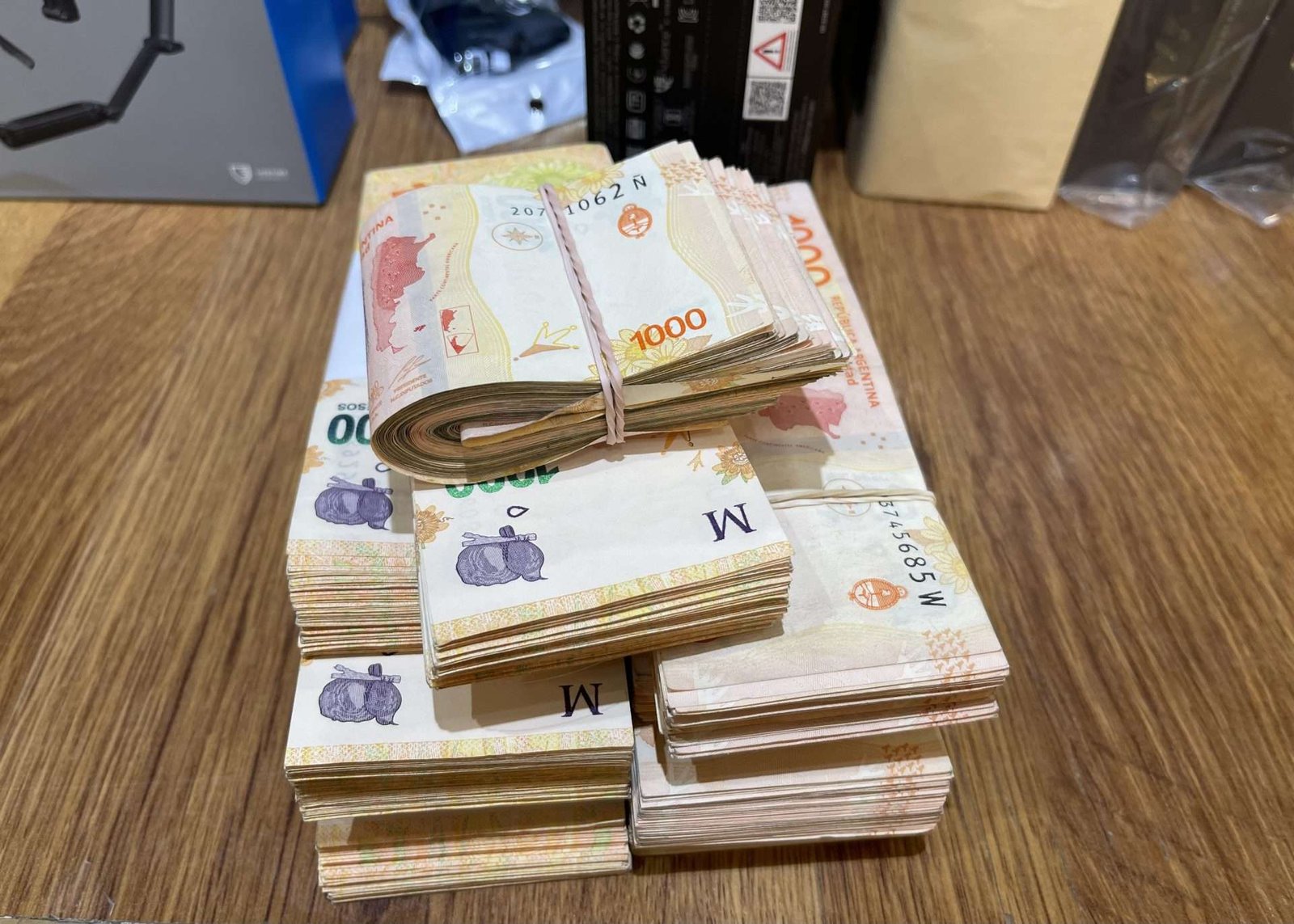
Eating Out In Buenos Aires
Palermo Hollywood and Palermo Soho have the highest density of restaurants anywhere in the city. And these are the suburbs where the younger crowd goes to have fun and be seen. It’s also where you’ll find the greatest selection of different cuisines and bars.
If you’re staying in the centre of the city and don’t feel like spending anywhere from 20-45 minutes in a taxi depending on traffic, Puerto Madero also has a large selection of restaurants and a vibrant bar scene.
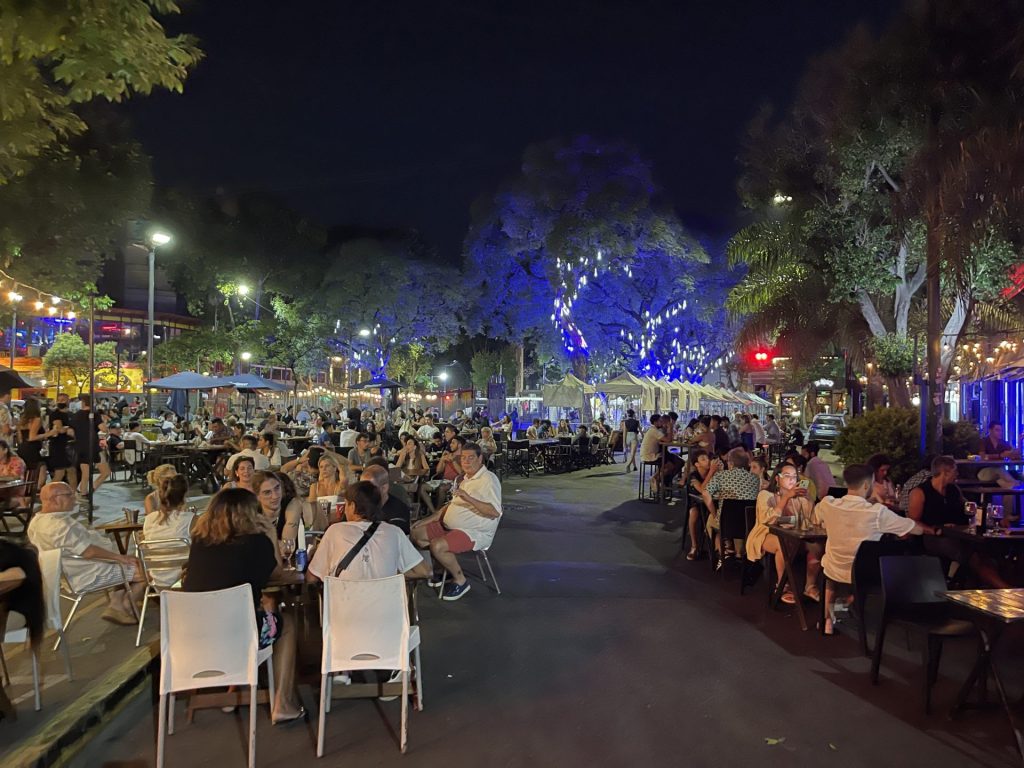
Where To Sit – Inside Or Outside?
In the warmer months I prefer sitting outside on the kerb. Particularly in the leafy green suburbs like Palermo. Where a restaurants tables outside can be like eating in a huge urban forest.
In the colder months and the dead of winter, sit inside. Or you’ll freeze in any of the outside dining locations.

Beware Of People Approaching Your Table
When sitting outside you need to keep an eye on your belongings. Don’t leave items like mobile phones sitting on tables. Any street vendor that approaches you may be running a distraction scam and may lift your valuables from the table.
Know The Prices And Payment Method Before Ordering
I’ve never encountered a restaurant that doesn’t except cash. But I have encountered plenty of restaurants that wont accept credit card.
Be sure you know the prices and have the correct payment method before ordering from a restaurant in Buenos Aires. You wouldn’t want to find out that they don’t accept credit card after ordering if credit card is all you have.
Popular Tourist Attractions In Buenos Aires
The big ticket items are listed below. Though my own favorite thing to do in Buenos Aires, is to just visit random Argentine malls like Galeria Bond Street. Or the world’s most beautiful bookshop with its cafe, called El Ateneo Grand Splendid.
What you’ll want to see and do will depend entirely on how long you have in the city. Personally, I just like wandering around discovering cafes, restaurants, hole in the wall bars and huge graffiti murals. BA is a huge and diverse city. There are beautiful spots waiting to be discovered, around every corner of the city.
My advice would be to hit the big ticket items below, and then just wander and explore the city. Go casually from barrio to barrio and savor the different flavors and vibes each suburb has to offer.
Once you’ve seen the main tourist sites below, wander off the beaten path and explore. Savor some of Argentina’s famed Malbec, or its world class beef. Try out the fantastic craft beers that abound in Buenos Aires. Relax, explore and enjoy the city. Particularly, if you’re here during the summer Christmas period.
Here’s the list of ‘big ticket’ or main tourist attractions in Buenos Aires:
- Obelisco
- Congreso Nacional
- Palacio Barolo
- Casa Rosada, Catedral Metropolitana & Plaza de Mayo
- Puerto Madero
- Recoleta Cemetery
- Museo Nacional de Bellas Artes
- La Boca
- San Telmo & Museo Histórico Nacional
- Teatro Colón
The Buenos Aires Obelisk called ‘Obelisco’
Obelisco, located in the heart of Buenos Aires, is an iconic monument that you should definitely visit during your trip to the city. Built in 1936 to commemorate the 400th anniversary of Buenos Aires’ founding, this towering structure stands proudly at the intersection of Corrientes and Avenida 9 de Julio.
As a symbol of the city, Obelisco has become a popular gathering place for celebrations and events, making it an integral part of Buenos Aires’ vibrant cultural scene. During the day, the Obelisco offers breathtaking views down Avenida 9 de Julio. And it’s a popular spot for visitors to the city to come and take a selfie or two in front of the BA hedges with the Obelisco in the background.
When night falls, the Obelisco and its surroundings transform into a mesmerizing spectacle of lights. The vibrant city lights illuminate the monument, creating a captivating ambiance that truly showcases Buenos Aires’ energetic nightlife.
Travel Tip: Be sure to get a photo from the Mirador del Obelisco that is situated on top of the city police station here. And do note, the area around the Obelisco is safe by both day and night. But when there is a protest happening, it’s best to avoid the area.
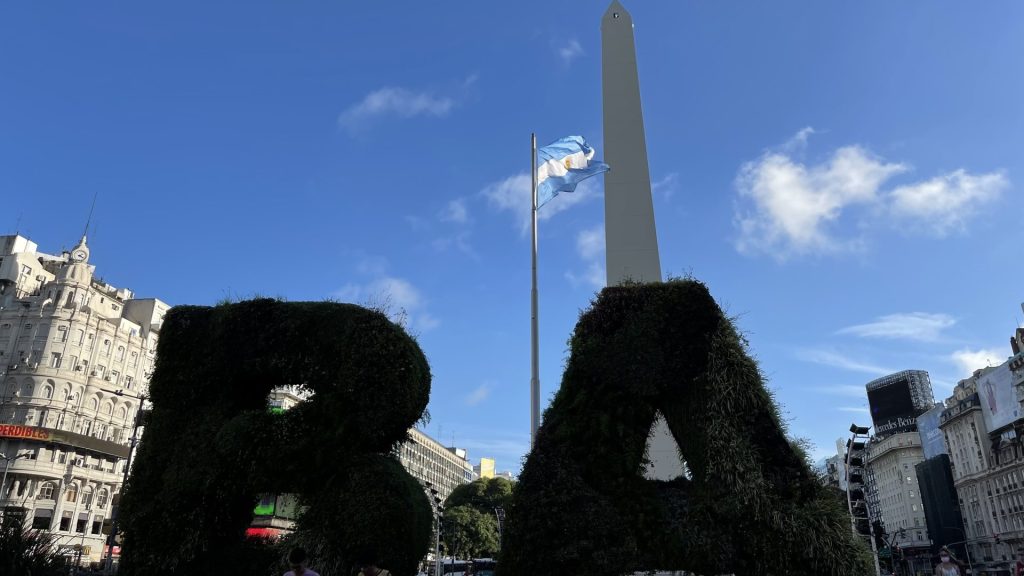

Congreso Nacional – The National Congress Building
As a tourist in Buenos Aires, one iconic landmark that you shouldn’t miss is the National Congress building. Located in the heart of the city, this monumental neoclassical structure serves as the seat of the Argentine National Congress. Designed by architect Victor Meano and constructed between 1898 and 1906, the building is a stunning example of architectural grandeur.
Standing tall with its white marble facade and an impressive bronze-plated dome reaching a height of 80 meters, the National Congress building is a sight to behold. And tours of the interior are available. And the Buenos Aires ‘hop on hop off bus’ for tourists stops out front.
Travel tip: Combine a visit to the National Congress, with a sunset tour of Palacio Barolo. The two iconic landmarks are less than 100 meters apart. And they sit at opposite ends of the Plaza del Congreso. From the roof of Palacio Barolo, you have spectacular sunset views out over the National Congress building.

Palacio Barolo – Dante’s Divine Comedy
Designed by Italian architect Mario Palanti in 1923, Palacio Barolo is a testament to the fusion of art and literature. Inspired by Dante Alighieri’s Divine Comedy, the building’s design takes you on a journey through the mythical realms of Hell, Purgatory, and Heaven. Each of its 22 floors represents a section of the epic poem, immersing visitors in a unique experience of symbolism and storytelling.
One of the highlights of my visit, was witnessing the breathtaking sunset views from the lighthouse atop Palacio Barolo. As the sun cast its golden hues over the city, I found myself standing on the building’s lighthouse, gazing at the magnificent sight of the Congress building in the distance. The panoramic vistas of Avenida de Mayo and the surrounding area, were simply awe-inspiring.
Now, while the building is 22 floors, it’s worth noting that the elevator stops at the 14th floor. And beyond the 14th floor is only accessible by a marbled staircase. The 14th floor is the end of ‘purgatory’ in Dante’s epic poem. And the soul is cleansed and ready to begin its ascent through the concentric rings to ‘heaven’. And this is why the last floors are only accessible by a spiraling marble staircase.
Travel tip: If you have difficulty climbing stairs, a tour of Palacio Barolo may not be for you. But, in the event you can make it up at least 2 flight of stairs, Salón 1923 sits on the 16th floor. Salón 1923 serves cocktails with an impressive sunset view out over Buenos Aires.
Plaza de Mayo – Casa Rosada And Catedral Metropolitana
One of the most vibrant and historically significant areas to explore in Buenos Aires is the Plaza de Mayo. Located in the heart of the city, this iconic square is surrounded by three remarkable landmarks – Casa Rosada, Catedral Metropolitana and the Cabildo. As I stepped onto the plaza, I was immediately captivated by its buzzing atmosphere.
Casa Rosada, the presidential palace, stands proudly on the eastern side of Plaza de Mayo. Its distinctive pink facade is a symbol of Argentine politics and power. Visitors can take guided tours of this historic building, exploring its grand halls and learning about its role in shaping the nation’s history.
The beautiful Catedral Metropolitana, located on the northern side of the plaza, is a stunning example of neoclassical architecture. As I entered the cathedral, I was struck by its grandeur and peaceful ambiance. The magnificent interior houses numerous chapels, a massive domed ceiling and intricate stained glass windows. It’s also the final resting place of General José de San Martín, one of Argentina’s most revered national heroes.
Located just a short walk from the Casa Rosada and Catedral Metropolitana, the Cabildo is a historic building that once served as the seat of the colonial government. Today, it houses a museum that showcases artifacts and exhibitions highlighting Argentina’s struggle for independence. Exploring these three landmarks in the Plaza de Mayo area offers a fascinating insight into the country’s political, cultural, and historical heritage.
Travel tip: It’s worth noting that the popular ‘hop on hop off’ tourist bus also stops at Plaza de Mayo, making it convenient for visitors to explore the area and discover the many hidden gems of Buenos Aires.
Bonus Travel Tip: When facing the Casa Rosada, if you walk past it on the left and down the slight hill, you will go past the Kirchner Cultural Center (worth a look). And onwards to Puerto Madero. Where you can enjoy a late lunch or early dinner and watch the sunset with a pint of craft beer or a cocktail in hand.
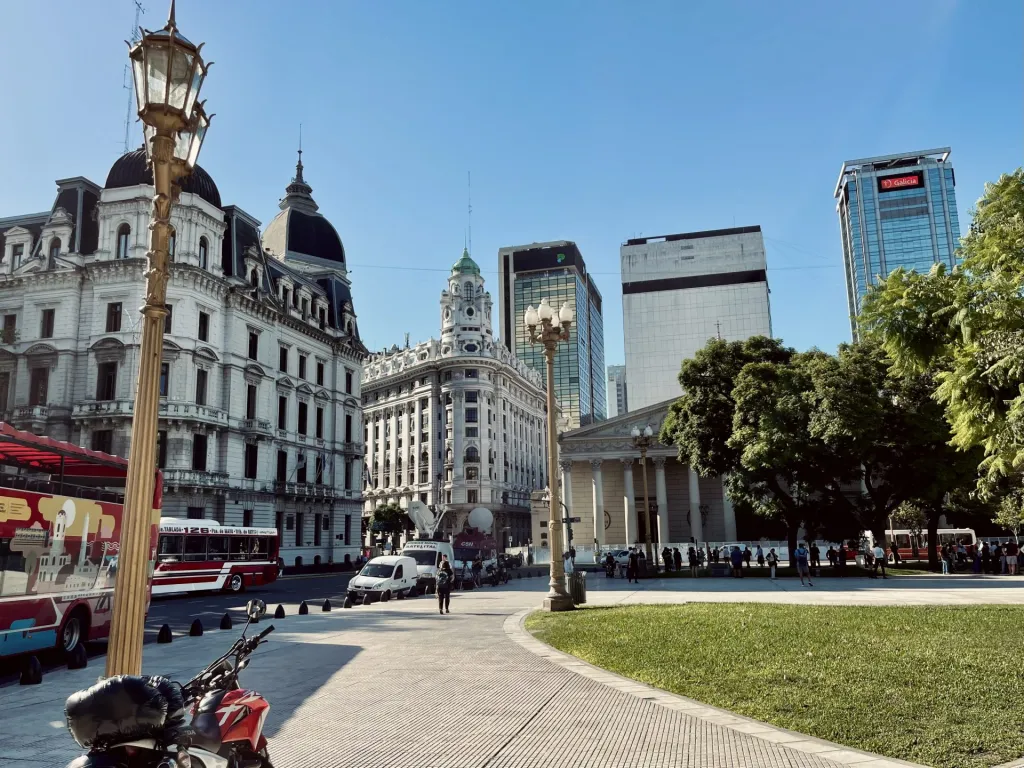
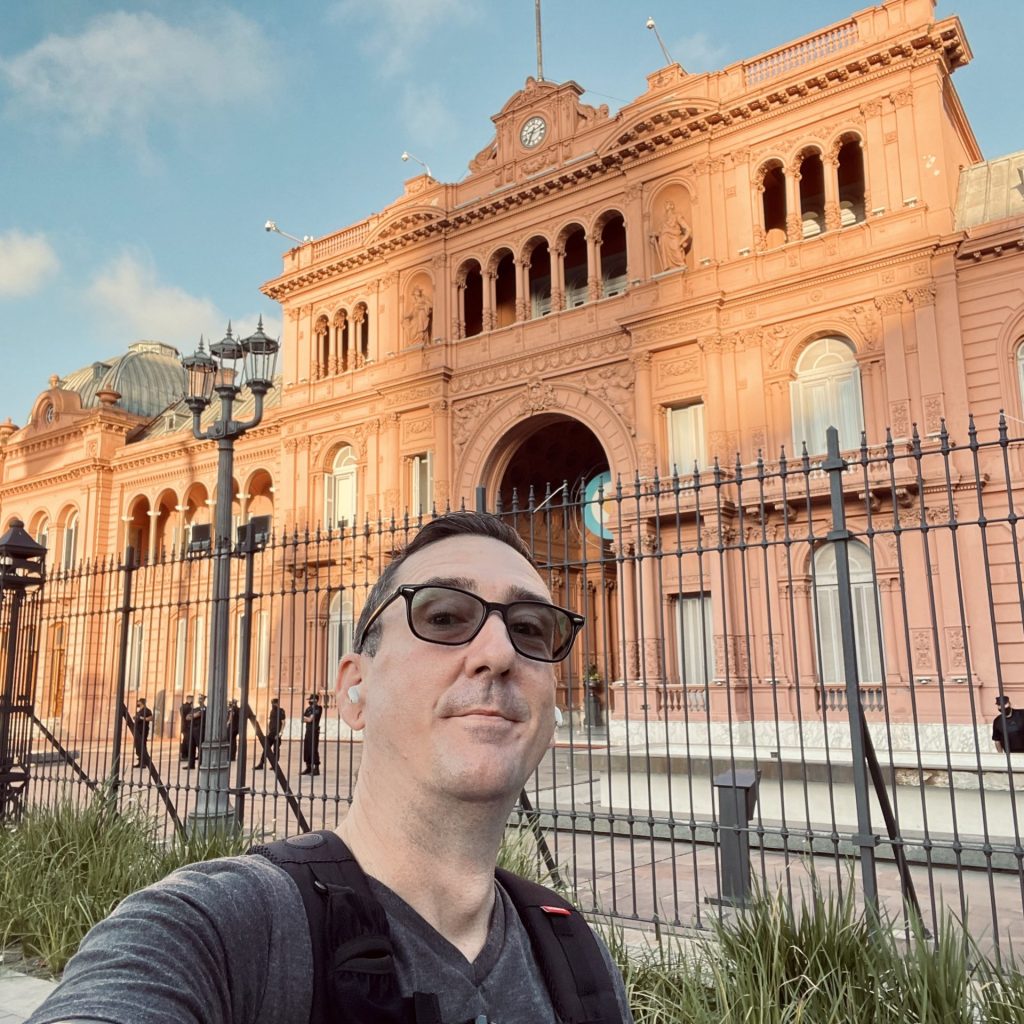
Puerto Madero – A Different Side Of Buenos Aires
As I strolled from Plaza de Mayo, I found myself immersed in the modern and vibrant atmosphere of Puerto Madero. This waterfront neighborhood, located just a short and easy walk away, offers a refreshing contrast to the historical charm of Buenos Aires. With its sleek high-rise buildings, picturesque docks, and scenic walkways, Puerto Madero is a must-visit destination for any tourist.
One of the highlights of Puerto Madero is its array of trendy restaurants and bars that line the waterfront promenades. As I settled in for a drink by the water, I couldn’t help but marvel at the stunning views of the sunset reflecting off the towering glass skyscrapers. The combination of the cool breeze, the shimmering lights, and the lively atmosphere creates the perfect ambiance for a relaxing evening or a memorable night out.
Whether you’re seeking a leisurely stroll along Buenos Aires ‘waterfront’, a delicious meal at one of the many restaurants, or a vibrant nightlife experience, Puerto Madero offers it all. With its convenient location just a short walk from Plaza de Mayo and its waterfront charm, this neighborhood is a must-visit for any tourist looking to experience the modern side of Buenos Aires while enjoying a drink by the water.
Travel tip: The old frigate, called the ‘Presidente Sarmiento’, is a maritime museum. And it’s open until 7pm most days. You can tour the frigate. Or just use it as the perfect backdrop for some magical holiday photos.
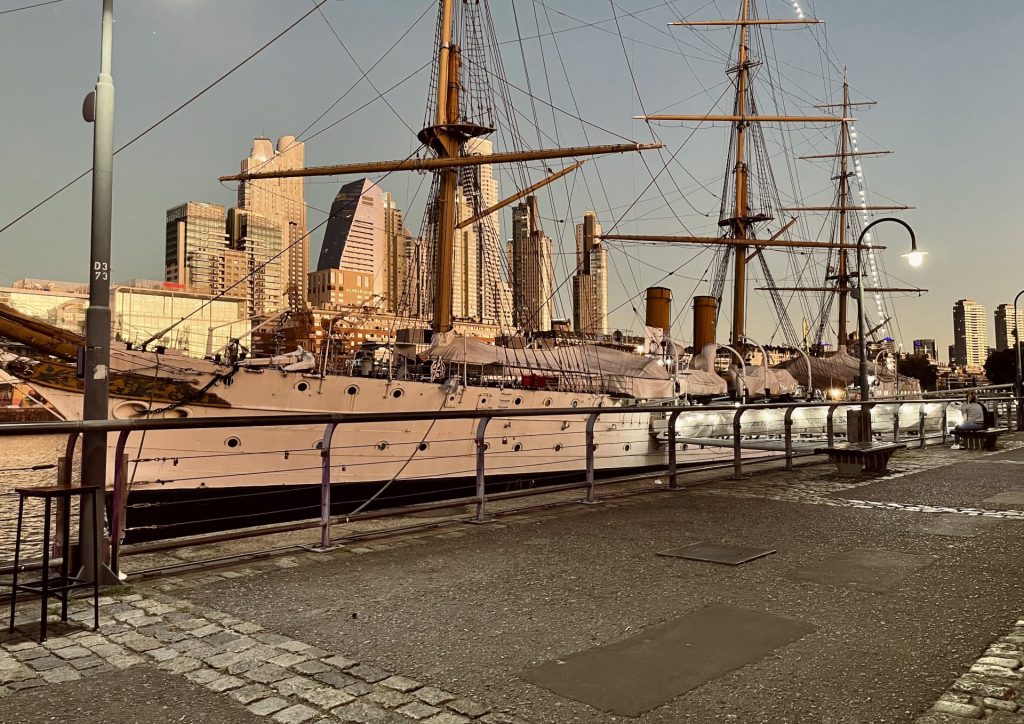
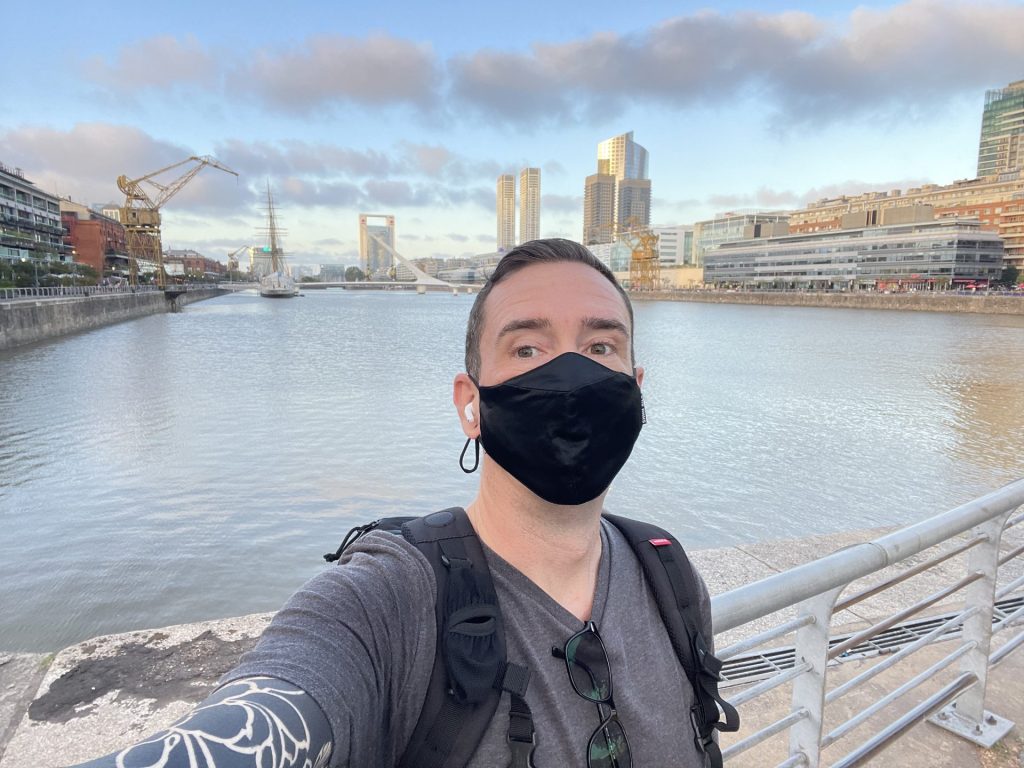
Recoleta Cemetery – A Maze Of Mausoleums
If you’re a fan of history, art, or simply enjoy exploring unique and captivating places, a visit to Recoleta Cemetery should be on your list of things to do in Buenos Aires. As I wandered through the narrow pathways of Recoleta Cemetery, I was struck by the sheer beauty and grandeur of the mausoleums that line the streets.
Each tomb tells a story, with elaborate sculptures, intricate details, and a sense of timeless elegance. The cemetery is not just a final resting place for the departed, but a remarkable open-air museum that pays tribute to Argentina’s most prominent figures, including Eva Perón. It’s a place where history comes alive, where the past and present converge in a hauntingly beautiful way.
Beyond its architectural marvels, Recoleta Cemetery offers a serene and peaceful atmosphere, providing a respite from the bustling city. Visiting Recoleta Cemetery is an opportunity to pay homage to the past, immerse yourself in the rich cultural heritage of Buenos Aires, and gain a deeper understanding of the people who have shaped the city’s history.
Travel tip: There are people standing around outside the cemetery offering their services as guides. Sometimes these people are legitimate guides and other times, not. I would recommend taking a reputable free tour like the one below.
Museo Nacional de Bellas Artes – Goya, Rembrandt, Van Gogh, Rodin and More!
Located in the Recoleta section of the city, the Museo Nacional de Bellas Artes stands as one of South America’s most significant cultural institutions. Its current home, the former Pump House in Recoleta, provides an elegant backdrop for the diverse range of artworks on display.
Established in 1896, this renowned art museum in Buenos Aires has become a haven for both international and Argentine art. The museum’s collection boasts over 13,000 extraordinary pieces, including works by revered artists such as Goya, Renoir, Manet, Monet, Gauguin, van Gogh, and Picasso, among others. From classical masterpieces to contemporary expressions, the museum offers a comprehensive panorama of artistic brilliance.
With its extensive collection, the museum presents a journey through time, allowing visitors like myself to immerse themselves in the beauty and creativity of Argentine and international art. The Museo Nacional de Bellas Artes is a must-visit destination for art enthusiasts and anyone seeking to explore the vibrant artistic legacy of Buenos Aires.
Travel tip: Situated in Plaza Sicilia, located near the corner of Libertador Avenue and Sarmiento Avenue, is a sculpture by Auguste Rodin. It was commissioned to honor Domingo Faustino Sarmiento. And it sits as one of the only foreign commissions in Rodin’s portfolio of works.


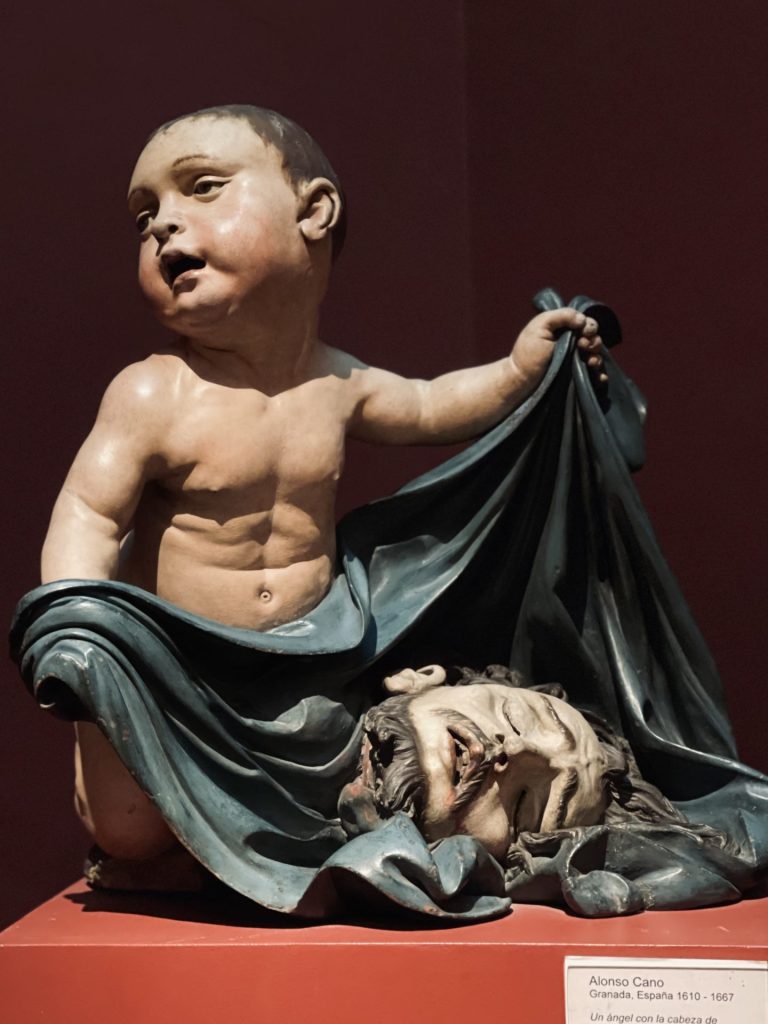
La Boca – Tango And Steak In Colorful Caminito
The neighborhood of La Boca, located at the mouth of the Riachuelo River, is known for its lively atmosphere. One of the main reasons why tourists should visit La Boca is its famous street, Caminito.
Lined with brightly painted houses, bustling tango dancers and vibrant street art, Caminito is a feast for the senses. Exploring this iconic street is like stepping into a living work of art, where every corner tells a story of Buenos Aires’ immigrant history and working class culture.
Another highlight of La Boca is the legendary La Bombonera stadium, home to the renowned Boca Juniors football club. For sports enthusiasts or even those simply curious about the passion of Argentine football, a visit to La Bombonera is a must.
The stadium tour provides an immersive experience, offering a glimpse into the fervor and spirit of the Boca Juniors fans. From the colorful streets of Caminito to the electrifying energy of La Bombonera, a visit to La Boca promises a vibrant and unforgettable experience for tourists seeking to immerse themselves in the cultural fabric of Buenos Aires.
Travel tip: It’s best to visit Caminito by yourself, using the ‘hop on hop off’ tourist bus. The area is safe during the day. Just take precautions against the ever present menace of pickpockets. Yet, to visit the stadium, you will need to take a guided tour.
San Telmo And The Museo Histórico Nacional
San Telmo, with its charming cobblestone streets and colonial architecture, is a neighborhood that captures the essence of Buenos Aires’ rich history. As I wandered through the lively streets, I couldn’t help but be captivated by the bohemian atmosphere and the vibrant energy that permeates the area.
One of the main reasons why tourists should visit San Telmo is its famous Sunday market, where artisans, vendors and performers, come together to create a colorful spectacle. From handmade crafts and vintage treasures to tango dancers and street musicians, the market offers a unique and immersive experience that truly showcases the soul of Buenos Aires.
Another must-visit attraction in San Telmo is the Museo Histórico Nacional, which stands as a testament to Argentina’s fascinating past. Housed in a beautifully restored 18th-century mansion, the museum takes visitors on a journey through the country’s history, from its colonial beginnings to its struggle for independence.
Travel tip: Palermo Soho looks very similar to San Telmo. Particularly, in and around Plaza Serrano. If you’re not going for the Sunday market or to visit the Museo Histórico Nacional, where the sword of General José de San Martín is under constant guard, then San Telmo might not be for you.
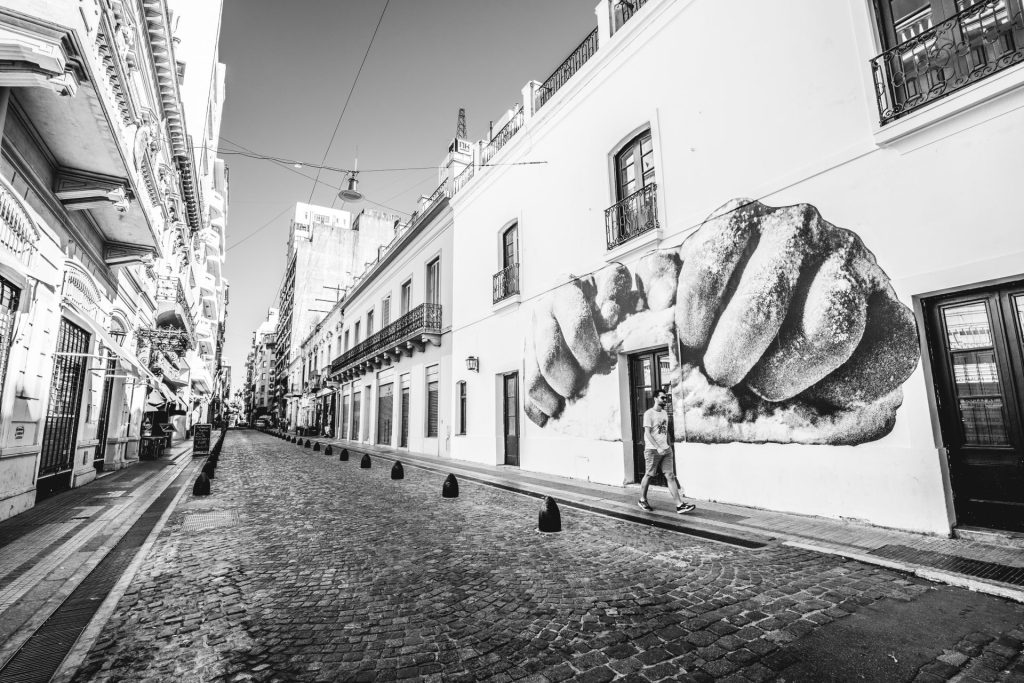
Teatro Colón – Buenos Aires Famed Opera House
This iconic opera house, comparable to the world-renowned theaters of La Scala and the Paris Opera, holds a prestigious place in the history of opera. Its rich and storied past, combined with exceptional acoustics and architectural grandeur, make it a must-visit destination for any tourist with a love for the performing arts.
The Teatro Colón showcases an impressive array of opera, ballet, and classical music performances, featuring world-class artists from around the globe. It’s not only a place to witness breathtaking performances, but also an opportunity to immerse oneself in the cultural heritage of Argentina.
The Teatro Colón stands as a testament to the country’s artistic excellence, providing an unforgettable experience that will leave visitors in awe of its beauty and the incredible talent showcased on its stage.
Travel tip: The ‘Mirador del Obelisco’, which is the vantage point for taking photos of the Obelisco, is 1 block away from Teatro Colón. And it’s a 3 minute walk. The ‘hop on hop off tourist bus’ will drop you off near Mirador del Obelisco. So, consider combining a visit to Teatro Colón with a visit to the Obelisco.
